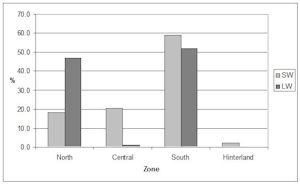
Elms Farm produced a large assemblage of artefacts used in all stages of textile processing, from the initial combing of the wool, to the production of sewn clothing. The most noticeable components of the assemblage are the spindlewhorls, a total of eighty-four, and the triangular loomweights, fragments from over 140 examples of which were recovered.
A large proportion of the spindlewhorls (54%) and loomweights (56% by weight) came from Period 2 contexts, and it is clear that the production of woven textiles must have been a major occupation during this period, continuing at least into the early part of the Roman era. Thereafter, the evidence is more difficult to interpret. The introduction of the horizontal loom to Britain by the Romans meant that loomweights were no longer needed, and all triangular loomweights from contexts after about AD 120 should be residual. There are ten spindlewhorls from contexts that are mid-Roman or later, but six of these are made from Late Iron Age grog-tempered fabrics, and are probably residual. It is feasible that spindlewhorls were made from sherds of pot over a hundred years old at their time of reuse, but the high proportion of whorls in this fabric would suggest a deliberate choice of 'antique' pottery, which seems unlikely. Of the remaining four spindlewhorls, two were made from sherds of (probably contemporary) greyware, one from septaria, and one from shale. There were no bone spindlewhorls. Unless the spindlewhorls in use at Elms Farm were made of perishable materials such as wood, it seems likely that the probable tally of four spindlewhorls of mid-latest Roman date does represent a decrease in spinning activity.
| Period | 2 | 2-3 | 3 | 4 | 5 | 5-6 | 6 |
|---|---|---|---|---|---|---|---|
| Iron woolcombs | 4 | 1 | |||||
| Bone metapodial tool | 1 | ||||||
| Bone weaving comb | 1 | ||||||
| Bone needles | 1 | 2 | 3 | 1 | |||
| Iron needles | 1 | 3 | 1 | 1 | 1 | 2 | |
| Copper-alloy needles | 3 | ||||||
| Total no. of objects | 1 | 1 | 12 | 5 | 2 | 3 | 2 |
An examination of the other textile implements from dated contexts reinforces the impression of a drop in textile-related activities at Elms Farm after Period 3. Figure 532 demonstrates that over half of the implements from dated contexts belong to Periods 2-3. Of those from later contexts, the bone weaving comb is a residual Iron Age object, and the metapodial tool is probably of similar date. Iron woolcombs appear to have been in use throughout the Roman period, so the single later Roman example from Elms Farm may not be residual.
It is also evident from Figure 532 that needles are particularly common at Elms Farm in Period 3 but not in Period 2 contexts, despite the abundance of evidence for textile production in Period 2. It might be expected that Period 2 needles would be predominantly made from bone, but since there was only a single needle from the period, it is impossible to comment. It should be noted here that bone objects as a whole were poorly represented in the assemblage from Elms Farm, particularly in Period 2; there was only one other bone object (a handle) from this period. The reason for this is unknown, and could possibly be due to poor bone preservation in parts of the site, though it seems unlikely that this is the sole explanation. Some Iron Age sites such as Danebury and All Cannings Cross (Cunnington 1923, 74) have produced large numbers of bone needles, demonstrating that sewing (assumed to be predominantly for the production of clothing) was a common practice. If the relative lack of needles in Period 2 is genuine, it suggests that either much of the textile being produced during Period 2 was destined for sale as cloth, rather than being made into clothes on site, or that tailoring of garments was minimal. The increased incidence of needles in Period 3 may denote a change in emphasis, with greater production of finished clothing on site. This may have coincided with a general reduction in the amount of cloth being made, since the deposition of spindlewhorls drops markedly in Period 3 (Figure 532).
The six woolcomb fragments from the site form one of the largest assemblages of such objects from the country, although only two are reasonably complete. The use and typology of woolcombs is discussed by Manning (1976, 33) and Wild (1970a, 24-6). There are two main forms, the 'East Anglian' type, which is single ended with a slot in the other end, and a double-ended type, which is the form found on the continent as well. The end teeth on this type are often inserted, as with SF3492. Elsewhere in Essex, double-ended combs have been found at Dunmow (Major 1997, 86, no. 41), Kelvedon (unpublished) and Great Chesterford (Manning 1976, 34, D3).
Most of the woolcombs from Elms Farm are too incomplete to be certain of the form, though SF3492, with its inserted end tooth, is probably double-ended. The majority of the woolcombs known from Essex are of this type, which is normally about 90-110mm wide. SF5595, which appears to have its full width present, is a mere 40mm wide, and is single-ended. It has splayed teeth, a feature shared by SF1362. It is small enough to be perhaps thought of as a miniature, but is not the only woolcomb from Essex of this size. There is an example from Dunmow Temple a mere 37mm wide, also with splayed teeth (possibly single, rather than double-ended: Wickenden 1988, 56, no. 14), from a late 2nd-early 3rd century context, and a second from close to Chelmsford Temple (Wickenden 1992, fig. 42.1) a mere 26mm wide, from a late 1st-early 2nd century context. Wickenden suggests that this should be regarded as a new type, which seems reasonable, and which might be termed the 'Essex' type. A further example cited by Wickenden, from the vicinity of Harlow Temple (unpublished, HMB 6739) appears from the drawing to be a double-ended comb, as it has two inserted end teeth.
The occurrence of 'miniature' woolcombs close to temple sites is somewhat suggestive of ritual connections, although none of the examples came from contexts that could be seen as ritual deposits. The two dated examples are early to mid-Roman; the Elms Farm miniature is, unfortunately, the only woolcomb from the site not from a dated context. SF1362, which may be of this type, is from an Early Roman context, as are all the other fragments from the site bar one (SF5373, Period 5-6).

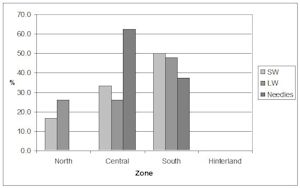
Only Areas E, F and I produced woolcombs (these are adjoining areas lying to the west of Road 1), suggesting that this area may have been particularly associated with primary wool processing. The distribution of the early Roman spindlewhorls and loomweights is somewhat different as both occur predominantly in the southern zone of the site (Figures 533 and 534). One can speculate that spinning and weaving was taking place in the latter zone.
1. Woolcomb fragment. The X-ray shows clearly that the teeth were inserted, as was the extant end tooth. An angled notch on the same edge is probably the seating for a missing inserted tooth at the other end. Surviving W. 51mm, L. 50mm. SF3492, Fill 10319, Unknown feature 10322, Area F, Period 3
2. Woolcomb fragment. The plate appears to be the full width, although very narrow for a woolcomb. The teeth are splayed, and damaged. W. 40mm, surviving plate L. 27mm, max. surviving teeth L. 32mm. SF5595, Cleaning layer 13316, Area I, not dated
3. Not illustrated. Woolcomb fragment, with slightly splayed teeth, and a small part of the plate. The full width is not present. A second small fragment is probably part of the same object, but is very mineralised. 33x30mm. SF1362, Fill 8094, Well 8188, Group 788, Area E, Period 3
4. Not illustrated. Three joining fragments of a woolcomb (old breaks) with mineralised wood on the surface. Only teeth are present. The piece is probably from the edge of a comb with unsplayed teeth, although there is no thickened side piece. L. 97mm, Th. 6mm. Fill 8094, Well 8188, Group 788, Area E, Period 3
5. Not illustrated. Woolcomb fragment, with teeth at one end. Not enough survives to ascertain the form, or whether it had inserted side teeth. The width may be complete. Max. surviving tooth L. 53mm, W. 42mm. SF6465, Fill 13891, Ditch 18204, Group 593, Area I, Period 3A
6. Not illustrated. Woolcomb fragment. The broken teeth are unsplayed. One edge of the handle may be present. 60x30mm. SF5373, Layer 10514, Group 838, Area F, Period 5-6
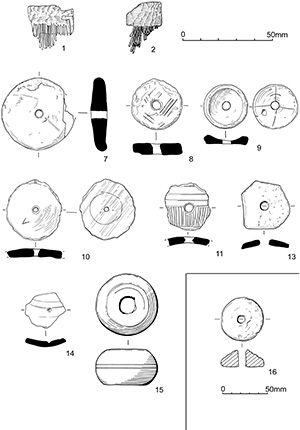
Cite this as: Tyrrell, R. 2015, Spindlewhorls , in M. Atkinson and S.J. Preston Heybridge: A Late Iron Age and Roman Settlement, Excavations at Elms Farm 1993-5, Internet Archaeology 40. http://dx.doi.org/10.11141/ia.40.1.tyrrell4
The site produced eighty-four spindlewhorls, eighty-two ceramic, one made from septaria and another example in shale, ranging in weight from 8g to 132g. There is little difficulty in accurately identifying the purpose-made spindlewhorls whether in ceramic or any other material, but those made from reused sherds of pottery are more problematic. In addition, three decorated lead weights, Type A2, Figure 524) may be whorls. This is, however, doubtful as they are somewhat small, with small perforations (3-5mm diam.). The small hole would only allow the use of a rather thin, and consequently flimsy, spindle.
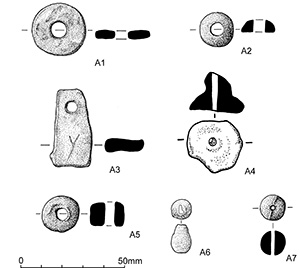
Barber (1991, 51) discusses the size of spindlewhorls in the Mediterranean world. She quotes Middle Eastern Islamic examples of 8mm in diameter as being the smallest then recorded and the diameter of the hole for the spindle-shaft ranged from 3 to 8mm. A thin spindle could easily be wedged into an over-large hole with a twist of yarn. She recorded a maximum weight of 140-150g in those she studied and underlines the fact that the weight is an important feature of these objects. Heavier whorls are needed to spin longer staple, stronger fibres and the smaller disc will spin faster and all this will affect the thread produced. The wide weight range of the Elms Farm examples may suggest that a variety of fibres were being worked on the site.
A number of objects, classified on-site as spindlewhorls, were returned to the pottery assemblage as merely sherds from pots that happened to have holes. Some reused pottery discs could also be considered here, as they may be undrilled whorls, but will be discussed with the other pottery discs. The author thinks that it is more likely that a prospective whorl-sherd would be drilled before grinding the edge to shape. It would seem a waste to edge-finish a sherd, which might subsequently break. The discs are possibly counters.
The Elms Farm spindlewhorls can be divided into four types by shape. Four were purpose-made, two of which are ceramic in a well-fired, grog-tempered fabric, with one example in shale, and a rather abraded septaria whorl. Eleven of the reused pot sherd whorls had ground, smooth edges, including a samian one. Six more had been carefully trimmed prior to grinding, including a sherd of amphora, and one had been particularly well trimmed. The remaining sixty-two sherd-made whorls have only been roughly finished.
Crummy (1983, 67) gives specifications for the spindlewhorls from Colchester. She suggests that the whorl should be of an even thickness and have smooth sides, features necessary to ensure that the whorl spins smoothly and produces an even thread. While the trimmed discs would function reasonably well as whorls, it is hard to see the roughly edged ones spinning efficiently. It is suggested that these are unfinished objects awaiting trimming. Two of the rough discs have depressions resulting from unfinished drilling; as already stated, trimming would need to be done after successful drilling.
Period 2 contexts produced 54% of the whorls, and another 14% come from features in Period 3 (Figure 536). It is also possible that those in many of the later contexts are earlier ones redeposited. In addition to this early slant to the assemblage, all but three of the pottery sherd whorls are made from Period 2 fabrics. The quantities of apparently unfinished whorls suggest that these objects were being made on site, either simply to meet the needs of the settlement or as trading items. A study of the spatial distribution puts the focus of this activity in Southern Zone of the site (Tables 109 and 110).
| Area | u/s | D | E | F | G | H | I | J | K | L | M | N | P | Q | R | W |
|---|---|---|---|---|---|---|---|---|---|---|---|---|---|---|---|---|
| No. | 2 | 5 | 2 | 9 | 6 | 11 | 1 | 4 | 8 | 12 | 5 | 13 | 3 | - | 1 | 2 |
| Zones | Northern | Central | Southern | Hinterland | ||||||||||||
| No. | 22 | 16 | 41 | 3 | ||||||||||||
| Area | u/s | D | E | F | G | H | I | J | K | L | M | N | P | Q | R | W |
|---|---|---|---|---|---|---|---|---|---|---|---|---|---|---|---|---|
| No. | 1 | 2 | 1 | 5 | 4 | 9 | - | 3 | 7 | 12 | 5 | 11 | 3 | - | - | 2 |
| Zones | Northern | Central | Southern | Hinterland | ||||||||||||
| No. | 12 | 12 | 38 | 2 | ||||||||||||
The author can only speculate regarding what happens to spinning in the later Roman period at Elms Farm. Only three whorls, one in fine greyware, one made from septaria and the third from shale, come from the later and latest Roman Periods 5 and 5-6. The greyware is a Roman fabric that may be contemporary with its context. Whorls may also have been made from materials that leave no evidence in the archaeological record, like wood, or possibly the previously flourishing craft of spinning may have declined.
The unillustrated spindlewhorls are listed in the archive catalogue.
7. Purpose-made, disc-shaped whorl, slightly thinner at the edges (Figure 535). Pottery fabric: GROG. Wt 102g. SF3530, Fill 5151, Pit 13366, Group 409, Area J, Period 3
8. A reused pot sherd with ground edges. The parallel grooves on one of the surfaces were probably on the potsherd prior to reuse. Pottery fabric: GROGC. Wt 50g. SF7832, 23009, Pit 23005, Group 236, Area N, Period 2
9. A reused pot sherd whorl, made from a base with the broken edges of the pot walls ground smooth. Four lines have been roughly scratched from the hole radiating outward. Pottery fabric: BSW. Wt 22g. SF7676, Machining layer 11000
10. Reused pot sherd, with trimmed edges and traces of a roughly inscribed circle concentric to the hole. Pottery fabric: GROG. Wt 48g. SF7300, 16029, Pit 16037, Group 200, Area H, Period 2B
11. A reused pot sherd whorl, with roughed-out edges. Pottery fabric: GROG. Wt 22g. SF7394, 14519, Pit 14561, Group 262, Area L, Period 2B
12. A reused amphora sherd whorl, with trimmed edges. Pottery fabric: AITAL. Wt 48g. SF6089, 13553, Layer 13553, Group 102, Area I, Period 2B
13. A reused pot sherd whorl, with roughed-out edges. Pottery fabric: GROG. Wt 26g. SF2850, 9163, Gully 9865, Group 2083, Area D, Period 2-3
14. A reused pot sherd whorl, with roughed-out edges and a partially drilled hole. Pottery fabric: GRS. Wt 13g. 8000, Machining layer 8000, Area E, unstratified
15. Shale. Sub-globular whorl, flat top and bottom, with two incised lines around the mid-point. A similar object from Segontium is cited as a possible sword pommel (Allason-Jones 1993, 206, no. 496), though this seems an unlikely interpretation at Elms Farm. Most shale spindlewhorls come from Late Roman contexts, as does this one. Wt 16g. Diam. 35mm, Ht 19mm. SF4638, Fill 10405, Ditch 10538, Group 838, Area F, Period 5-6
16. Septaria. A purpose-made, domed whorl. Wt 30g. SF5771, Pit 10910, Group 676, Area N, Period 5
Cite this as: Tyrrell, R. 2015, Ceramic loomweights, in M. Atkinson and S.J. Preston Heybridge: A Late Iron Age and Roman Settlement, Excavations at Elms Farm 1993-5, Internet Archaeology 40. http://dx.doi.org/10.11141/ia.40.1.tyrrell3
The excavations produced 443 fragments from 142 triangular loomweights, weighing 36.5kg. In addition, there were two pieces of a Bronze Age cylindrical loomweight from a prehistoric post-hole (13440) in Area J (described in the report on the prehistoric activity at Elms Farm: Tyrrell 2001, 67). Two truncated pyramidal objects (nos 24 and 25), which may be weights, but not necessarily loomweights, are included here.
There are also a number of baked clay blocks of uncertain function from the site. These are not discussed here because they do not have any holes, but could possibly have been tied to the warp threads of a loom.
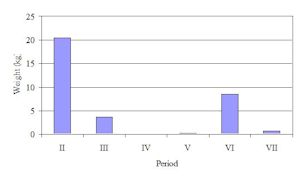
Triangular loomweights are a typically Iron Age form, used on warp-weighted looms, and thought to pass out of use in the 1st century AD (Major 1982, 111). By weight, 56% of the Elms Farm examples came from mid-1st century BC to mid-1st century AD contexts (Figure 537). However, a group of loomweight fragments was found at Ardleigh, Essex (Major 1999c, 157), dumped in a disused Roman kiln. Assuming from their condition that these were not redeposited, the author surmised that the vertical loom was still in use in the early 2nd century AD. A close study of the pottery dates of the twenty-three Period 3 weight fragments from Elms Farm shows that only three of these were from contexts that clearly dated to later than the early 2nd century. The dating of the other contexts is less reliable in that while they may continue into the early 2nd century, they actually start earlier. So while triangular weights may continue in use later than has been usually accepted, the evidence from this site is insufficient to resolve the case. Another lesser peak of quantity in Period 6, 23% of the total by weight, is probably a result of redeposition owing to later disturbance.
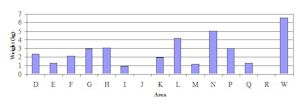
Figure 538 gives the quantities of loomweights in each area and shows a peak in the material from Area W. This results from the good state of preservation of the material from Area W, in that the group consists of largish fragments of eleven weights; the lesser peak in Area N represents pieces of twenty weights, but in smaller fragments. The peaks of quantities in Areas L and N may be the result of the density of pitting in those areas during Period 2. The differences between the other areas are less pronounced, with the exception of Areas R and J. The presence of as little as 32g of material in Area J underlines the non-domestic nature of the temple precinct. The complete lack of fragments from Area R may be because most of the activity in this area of the site occurred after Period 2.
The loomweights were examined macroscopically and divided into three fabrics according to the frequency and nature of the inclusions. Fabrics A to E were used in the classification of the daub.
Fabric F A poorly mixed fabric with sand, irregular fragments of quartz and flint pebbles. The colour is brown through to reddish at the core. There is 29641g of this fabric.
Fabric G This fabric had very little tempering, a small amount of sand and vegetable matter. The clay was evenly brown in colour, darkening slightly at the core. There is 3711g of this fabric.
Fabric H A similar fabric to F but with smaller inclusions and some vegetable tempering. The surfaces have dense vegetable impressions. There is 3209g of this fabric.
The majority of the loomweights (123) were in Fabric F, with fourteen in Fabric G and five in Fabric H. The significance of the fabrics is not clear. They do not appear to correlate with period, deposition or shape. Weights with saddle-shaped tops, for instance, were made in all three fabrics.
Although the variation in size of the loomweights from Slough House Farm, Essex, was thought to relate to a difference in period (Major 1998d, 161), this does not appear to be the case with the Elms Farm assemblage.
Because of the hand-made nature of objects they vary in size and style. Although none of the almost complete examples had all their corners intact, it was possible to measure some of the complete side lengths. Details of the range of dimensions present are given in Table 111.
| Average | Range | No. of examples | |
|---|---|---|---|
| Length of side | 137mm | 110-165mm | 7 |
| Thickness | 72mm | 54-100mm | 25 |
| Weight (all weights over 1kg) | 1338g | Max. 1800g | 8 |
| Hole diameter | 12mm | 7-20mm | 61 |
It is assumed that they would have had a suspension hole across at least one corner and possibly through all three corners. However, only three weights are complete enough to be certain that three holes were present. Indeed, one other substantial weight, from spread 75 in Area W, appears to have only one hole, but eleven separate fragments have at least two holes. In all cases the holes were made when the clay of the weight was soft. The holes through twelve of the weights were positioned close to the corners, but in five more the holes were positioned nearer to the centre of the side of the weight. There does not seem to be any pattern to this feature, so perhaps this positioning always varies but is only apparent in a large group.
Eight of the loomweight fragments have a saddle-shaped apex. This feature has been noted at other sites. At West Stow, Suffolk (West 1990, 68), the saddle-topped triangular loomweight found was from a 1st-century BC to 1st-century AD context, whereas the plain examples were found in 3rd to 1st-century BC contexts. The Elms Farm plain loomweight tops are all from Period 2 contexts, while the saddle-topped examples were found in Periods 2, 3, 4 and 5. The fragments in the later contexts were found with residual pottery, which suggests that they may be redeposited earlier weights. However, there is a slight suggestion here that the saddle-shaped apices could be a late feature.
While no two weights are exactly the same in shape because of the hand-made nature of these objects, some stand out of the assemblage as different in character. One weight (no. 17), from pit 23124 in Area N, is very crudely shaped, with unusually sharply moulded edges and a rather angular saddle top. Two of the loomweights, from 11091 and 14580, are more carefully moulded than the rest of the assemblage, having completely flat faces and straight edges. These weights, like the majority of the assemblage, are from late 1st-century BC to early 1st-century AD contexts.
One of the weights (no. 19) from a pit in Area N has been marked with a cluster of three small irregular impressions poked into the surviving face of the weight. Whether this is some form of maker's mark or merely accidental is difficult to be certain. There is a Late Iron Age weight from Rivenhall (Rodwell and Rodwell 1993, 59) with a line of small dots, made with the teeth of a comb, but this too could be accident rather than design. The early to mid-1st century AD pottery, found with the Elms Farm weight, means it may be slightly later than the one from Rivenhall but fits into the general period of loomweight deposition. Although the pit in question (11092) is phased as Period 3, the weight came from the earliest fill.
The loomweights were examined for signs of wear that might indicate the way in which they were used. The weights from Burgh, Suffolk (Martin 1988, 63) were considered to have wear-patterns around the holes that indicated they were hung point downwards. Despite the large quantities of material, little evidence of wear of this type could be detected on the Elms Farm weights. However, the weight from post-hole 8790 in Area P (no. 21) has short grooves on one side of the apex. If a cord were tied through the holes, and the weight hung from this with the point down, this seems to be where the weight would be chafed. It is possible that the grooves in the saddle-shaped apices were designed to keep a tie round the edge of the weight in place as it pointed downwards.
Two baked clay weights (nos 24 and 25) are truncated pyramids, with a single hole through the narrower end. They are both well moulded, with one slightly larger than the other, somewhat lop-sided, and small compared to the triangular weights. A complete and very similar object was found with Late Iron Age pottery in a pit at Cressing Temple, Essex (Tyrrell in prep). If they are loomweights, rather than weights used for some other purpose, they were possibly for weaving either fine textiles or perhaps braid. There are few parallels from Britain. When describing the Dragonby example (Elsdon and Barford 1996, 330, no. 2), which is also very similar in shape and date, Barford suggests that these 'mini' weights could have been used alongside the larger ones to allow the weaving of stripes or tartans.
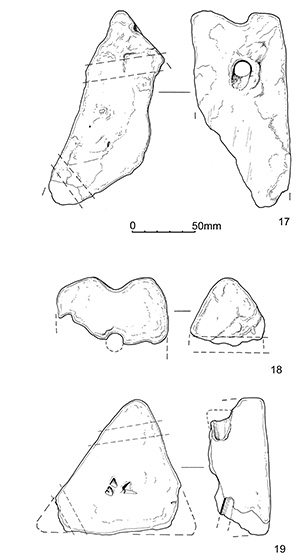
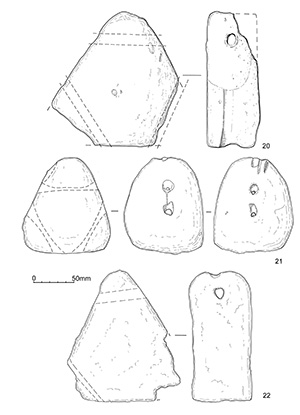
17. Triangular loomweight, crudely made, but with sharply moulded edges and a saddle top, Fabric G. SF4829, Fill 23056, Pit 23124, Group 236, Area N, Period 2B
18. A rounded triangular loomweight with a saddle top, Fabric F. SF7865, Fill 11306, Pit 11316, Group 227, Area N, Period 2A
19. A smooth well-moulded triangular loomweight with a possible decoration of three small holes, Fabric G. SF7650, Fill 11091, Pit 11092, Group 667, Area N, Period 3
20. A plain-topped triangular loomweight, Fabric F. SF218, Fill 81, unknown feature, Area W, Period 6?
21. A plain-topped triangular loomweight with bulging sides and grooves on the apices, Fabric F. SF6309, Fill 8789, Post-hole 8790, Group 1272, Area P, not phased
22. A well-moulded triangular loomweight, Fabric H. SF6233, Fill 14580, Pit 14579, Group 264, Area L, Period 2B
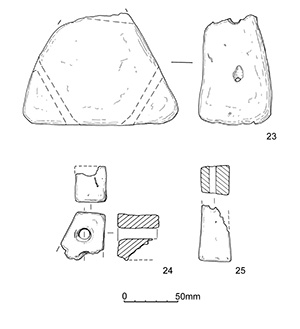
23. A plain-topped triangular loomweight, Fabric F. SF2219, Fill 10147, Pit 10146, Group 297, Area F, Period 2
24. The upper section of a truncated, pyramidal object with a hole just below the top, possibly a loomweight Fabric G. SF8406, Fill 5808, Group 398, Area J, Period 3B
25. The lower portion of a truncated pyramidal object, damaged top, possibly a loomweight Fabric G. SF8407, Fill 23056, Pit 23124, Group 236, Area N, Period 2B
This tool is similar to a number of metapodial tools found at Dragonby (Taylor and May 1996, 353-7), mostly in Late Iron Age, and some Early Roman, contexts. The Elms Farm example is from a mid-Roman pit, and may be redeposited. Although the Lincolnshire examples have a variety of wear patterns, it was thought most likely that they functioned as weaving bobbins.
26. Not illustrated. A metapodial tool, perforated along the length and through the shaft, but broken off at the central hole. No signs of wear could be determined since the object is so fragmentary. L. 73mm, Diam. 16mm. SF5702, Fill 4925, Pit 4943, Group 739, Area K, Period 4
Bone weaving combs are a distinctive Iron Age form (Hodder and Hedges 1977), and this example must be residual in its context. Although common in some parts of the country, particularly the west of England, they are very rare in Essex. There is a more complete example from Great Dunmow (Major 1997, 86), and another from North Shoebury (Brown 1995, 127).
27. Fragment from a weaving comb, with one surviving tooth. Scorched and partly carbonised. The edge is unfinished rather than rounded, as it would normally be, but this may the result of flaking due to the burning rather than to the artefact being unfinished. L. 38mm, W. 20mm. Fill 14564, Stoke-hole 14565, Group 5017, Area L, Period 5
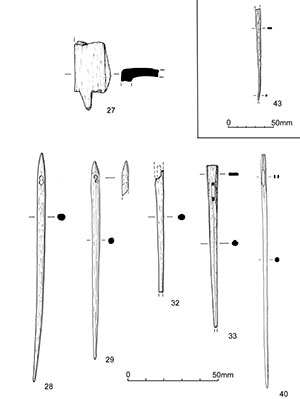
The bone and metal needles have been classified using the Colchester type series (Crummy 1983, 65-7).
Seven bone needles were recovered (Figure 542). Types 1, with pointed heads, and 2, with flat heads, were noted. At Colchester, both types had wide date ranges within the Roman period. The Type 1 needles from Elms Farm all come from late 1st to mid-2nd century contexts, with the exception of one (SF396) that is probably residual in a later midden context. The Elms Farm Type 2 needles are from mid- to Late Roman features.
Crummy (1983, 65) experimented with a 6mm diameter needle sewing through cloth of seven warp threads per 10mm. She found that the thick needle did not leave large holes because each new stitch closed up the previous holes, and that this was particularly so for the needles with spatulate heads. She also suggests that for finer, closely woven cloth a thinner needle is necessary.
28. Figure-of-eight eye. Complete. SF 4187, Fill 4978, Pit 4979, Group 755, Area K, Period 3
29. Figure-of-eight eye. Complete. SF6103, Fill 13793, Trench 18697, Group 613, Area I, Period 3B
30. Not illustrated. Figure-of-eight eye. Shaft broken off. L. 58mm, Diam. 4mm. SF5291, Fill 4081, Pit 4080, Group 62, Area K, Period 2
31. Not illustrated. Figure-of-eight eye. Part of head with most of shaft broken off below the eye. L. 25mm, T. 2mm. SF396, Layer 13211, Group 640, Area I, Period 4
32. Rectangular eye. Part of head and tip broken off. SF6836, Fill 4011, Pit 4083, Group 739, Area K, Period 4
33. Rectangular eye, point broken off. SF5949, Fill 15280, Pit 15271, Group 468, Area M, Period 4
34. Not illustrated. Rectangular eye. Part of head and tip broken off. L. 24mm, Diam. 3mm. SF2018, Cleaning layer 5307, Area J, Period 5-6
There were seven copper-alloy needles, all Crummy's Type 3 (Figure 542). All the Colchester Type 3 needles were from 3rd and 4th-century contexts, and this was postulated to be the general date for the type. However, both of the stratified examples from Elms Farm came from Period 3 contexts (Early Roman). A similar situation was noted at Castleford (Cool 1998, 92), where all five Type 3 needles came from Antonine or earlier contexts. It is therefore reasonable to suggest that the type was in use throughout the Roman period, and that the Elms Farm examples are not intrusive.
35. Not illustrated. Broken across the bottom of the eye and bent. L. 85mm. SF9513, 3999, Spoil-heap
36. Not illustrated. Complete, with a slight curve. There is a groove above and below the eye. Good condition. L. 125mm, Eye L. 9mm, max. W. 3mm. SF674, Machining layer 4000, Area A, unstratified
37. Not illustrated. Complete but in two pieces, and with one side of the eye missing. Fair condition, surface obscured by earth. L. 101mm. SF1153, Fill 4243, Pit 4211, Group 756, Area K, Period 3
38. Not illustrated. Head damaged, almost complete, tip bent. It has short, shallow grooves above and below the eye, on one face only. Condition fair, surface flaked in places. L. 79mm. SF1390, Fill 5146, Pit 5147, Group 409, Area J, Period 3
39. Not illustrated. Point missing, bent. L. 86mm. SF1992, Unknown context 5385, Area J, not dated
40. Complete and in good condition but cracked across the eye. SF6104, Fill 13822, Trench 13756, Group 613, Area I, Period 3B
41. Not illustrated. Broken across the base of the eye, with the point missing. L. 100mm. SF7278, Cleaning layer 18737, Area J, not phased
There were ten iron needle fragments (Figure 542), mostly the standard Crummy Type 3. However, there were also one definite and two possible examples of Crummy Type 2a, which has a spatulate head, and is rare in iron.
Not all objects resembling Type 2a needles have been identified as needles. Manning (1985a, 86, N9) illustrates an example from London as a stylus, while noting that the hole in the eraser is probably intentional. The criterion for Crummy's Type 2 needle is a flat spatulate head; the material can be copper alloy or bone. While most examples have fairly narrow heads, and are clearly needles, some in copper alloy have broad, flared heads, similar to stylus erasers, with the eye set at the base. The shafts are mostly thin compared to definite styli, as with the Elms Farm and London examples in iron, and it seems more likely that they are genuinely needles rather than an unusual form of stylus. Indeed, they may be more common in iron than is apparent, since without the benefit of X-rays they are indistinguishable from styli. The type in copper alloy is predominantly 1st-2nd century AD, as is the illustrated example, with a second example from a latest Roman ditch. The third example (SF4148) is from a pre-Roman pit [4786], possibly back-filled by the end of the 1st century BC. While it could be intrusive, it may be a genuine Late Iron Age artefact. Iron Age iron needles are rare; there are, for example, none in the finds reports for Danebury, which had over fifty bone needles. Certainly, bone seems to be the favoured material for Iron Age needles, and SF4148 may be copying a form primarily found in bone. The Danebury Class 4 needles have relatively wide, flat heads, corresponding broadly to Crummy's Type 2a, but appearing less well finished (Sellwood 1984, 380). One of the illustrated examples (fig. 7.32:3.83) has a head as broad as SF4148, and it may be that the Roman type has an Iron Age ancestry.
In addition to the definite needles, some fragments of wire could be needle shafts or points (included in category 20). The most likely needle fragments are from 5610 (undated cleaning layer); 7598 (undated collapse); 10000 (Period 4 pit); 10071 (Period 3B gully); 10621 (Period 4 pit); 13419 (Period 2-6 layer); and 20031 (Period 2 pit).
42. Not illustrated. Four fragments (broken in antiquity) of a Type 2a needle, point missing. Head W. 9mm, surviving L. c. 64mm. SF4148, Fill 4874, Pit 4786, Group 276, Area K, Period 2
43. The top of the head and the point are missing, both old breaks. In two pieces, broken in antiquity. L. 101mm. Fill 13387, Pit 18019, Group 3024, Period 3
44. Not illustrated. Needle fragment, with an oval hole. A second, spatulate, fragment is probably the head of the needle, which would thus be a Crummy Type 2a. L. 41mm, head W. 10mm. Fill 5376, Ditch 5359, Group 443, Area J, Period 6
45. Not illustrated. Fine needle, broken across the eye. The point is probably missing. The slit is a long rectangle, with the head bulging slightly round it, comparable to e.g. Manning D27-32. The metal is so thin at the eye that it barely shows up on the X-ray, demonstrating the difficulty of identifying needles of this fineness, unless complete. L. 44mm, Diam. 1mm. SF2296, Cleaning layer 5603, Area I, not phased
46. Not illustrated. The details of the eye are unclear, but it is probably fairly long, with little swelling of the head. L. 84mm, diam. 1.5mm. SF4148, Pit 4786, Group 276, Area K, Period 2-3
47. Not illustrated. Both ends missing, broken across the bottom of the eye. There is a groove below the eye, possibly on one face only. This would have been a fairly small needle. L. 23mm. SF2024, Cleaning layer 5307, Area J, Period 5-6
48. Not illustrated. A small, fine needle, point present but broken across the eye. L. 31mm. SF4755, Layer 5907, Group 601, Area I, Period 3B
49. Not illustrated. Point missing, broken across the bottom of the eye. Slightly bent. L. 64mm. SF7417, Pit 15757, Group 900, Area M, Period 3
50. Not illustrated. Pointed wire, circular section, tip bent. This is probably a needle, broken at the base of the eye (a fresh break); there is a slight suggestion of the beginning of an eye on the X-ray. L. 52mm, diam. 1.5mm. 7115, Pit 7114, Group 885, Area G, Period 6
51. Not illustrated. Head fragment. Hole L. 3mm, L. 26mm, Diam. 1mm. 5393, Pit 5394, Group 432, Area J, Period 5
The iron tools from Elms Farm form a large, varied and important group. Many are, unfortunately, incomplete, and some difficulties were encountered categorising some tools. The tips, in particular, were sometimes damaged, making objects such as small punches and awls difficult to distinguish from one another. The number of objects in this function category should undoubtedly be even larger, since any small, pointed bar fragments were classified as nail shafts unless there was any indication to the contrary. Very few bar fragments were cleaned, so it was not possible to distinguish between those with square sections, which were more likely to be nails (or could have been parts of tool tangs) and those with circular sections, which were probably not nails.
The following are iron unless otherwise specified.
Thirty-nine iron knives were identified. In addition, there were another thirty-one single-edged tool fragments that could be parts of knives, or could be from other types of blade, and a copper-alloy handle fragment. Few of the knives were cleaned, and some drawings therefore lack sections.
The knives have been classified according to the form of their handle, or tang shape where the handle is missing. The terms scale tang and whittle tang have been adopted for convenience; they are in general use in medieval finds reports, though rarely used in Roman ones, but the forms are the same.
Scale tang knives have broad, flat tangs to which the bone or wood handle plates were riveted. They are relatively rare forms in both the Late Iron Age and the Roman period. In Manning's typology (1985a, 108ff) most of the forms with scale tangs are Early Roman types. There were three definite and two probable examples from Elms Farm, one from Period 2, two from Period 4, and two undated.
Knives with integral handles are also largely Early Roman. Many of the forms are distinctive in shape, with examples from different sites closely resembling each other, and it is likely that these were not locally made. There are four from the site, all of different types. Two are standard Early Roman types, but two are more unusual. One (SF6454) is a variant of Manning's type 8, which he cites as a rare Early Roman form. The other (SF3999, from a mid-later Roman context) has a broad, flat handle resembling a scale tang, but with no rivet holes, and it does not conform to any of Manning's knife types.
There are three socketed knives, one of which is possibly a small cleaver, from a Late Iron Age context.
Whittle tang knives, the most common form at Elms Farm with sixteen examples, occur throughout the life of the site, and most require no comment. The type would have had a one-piece handle, which has survived on only one knife. The group includes a small knife with an unusually shaped blade (SF1954), which may have been used for a specific purpose. There is also an unfinished knife, abandoned during the formation of the tang.
The two copper-alloy knife handles found are probably both the same type, though one is damaged and in poor condition. This form of handle is discussed in Greep (1982), where he calls it the 'London Type', although found at other sites. Most examples are made of bone, and of the twenty examples listed by Greep, only one (from Vindonissa) is made of copper alloy, so these examples are very rare finds. Local examples in bone include several from Colchester (Crummy 1983, 107-9). Their date is Claudian-Neronian to early Flavian.
Finally, there are five folding knives. One is a well-known, though not very common, standard form, with a copper-alloy handle depicting a dog and hare. It belongs to Lloyd-Morgan's Group II, with parallels cited by her from London, Cirencester, Duston (Northants), Hadstock, Chesters Museum, Corinium Museum, and Richborough (in Garrard 1995, 1035, no. 452), and there is a further example from Cottenham, Cambs (Taylor 1987, 8, no. 23). The second is a fragment from the copper-alloy handle of an unusual knife, apparently with a pivoting blade, and possibly incorporating a second blade or other implement. Only one parallel has been identified, from Wroxeter (Bushe-Fox 1914, 14, no. 19). Neither example is dated.
The other three are entirely of iron, two with tubular sockets and one with a tang. The tubular form in itself is not very rare, but is normally made from copper alloy, with an iron blade, and is commonly described as a razor handle. There are two examples from Exeter (Allason-Jones 1991, 249, nos 52 and 53) from contexts dated c. 275 and late 3rd-4th century; three from Chichester (Down 1978, 293, no. 27; Down 1989, fig. 27.2.25 and 28.3.31), all from post-Roman contexts; and an unstratified example from Brancaster (Sparey Green and Hinchliffe 1985, fig. 33, no. 63). One of the Chichester examples retains its horn handle, and some have decoration on the copper-alloy ferrule, walked scorper at Chichester and hatched at Brancaster. Parallels made entirely from iron are very rare; there is one from Lowbury Hill, Berkshire, which is very similar, though with a slightly different shape to the blade (Atkinson 1916, 50, no. 20). Atkinson notes a further folding knife from Woodcuts. Another possible example, from Richborough (Henderson 1949, 132, no. 145 and pl. XXXIX), is an object that appears to be a closed folding knife, lacking the pivot end. The slightly tapering ferrule is stated to be made of iron, but coated with bronze. It is possible that the socket is in fact copper alloy, as with the other examples, the apparent iron component being the result of corrosion from the blade. The third folding knife from Elms Farm, with a whittle tang to the handle, appears unique, though its form seems related to the socketed examples. The Lowbury Hill knife has a tang of sorts, very short and flat, though on the blade rather than the handle.
Both the socketed folding knives may have come from the same pit (14099), as although one was from a cleaning layer, part of it came from a spot directly over the pit. They could therefore be a true pair. The presence of three very unusual folding knives on a single site suggests that they may have been made at Elms Farm, in imitation of the copper-alloy version. This is further supported by a possible unfinished folding knife blade from another feature (SF3567).
1. Knife with a relatively narrow scale tang set centrally, with very decayed organic matter on the handle and blade. There is a rivet through the tang, in totally corroded grey-green metal, probably copper alloy (Vanessa Fell). L. 151mm, blade W. 20mm. SF7007, Fill 11487, Pit 11785, Group 1242, Area N, Period 2
2. Not illustrated. Knife blade fragment, complete as buried, but with both ends missing. Parallel-sided blade with a scale tang. Blade L. 38mm, W. 20mm. Tang L. 18mm, W. 9mm. SF8039, Fill 4844, Pit 4913, Group 4016, Area K, Period 4
3. Not illustrated. Probable knife fragment, with a parallel-sided blade and a scale tang. Both ends are missing. L. 71mm, max. blade W. 22mm, tang W. 16mm. SF1827, Fill 10000, Pit 10062, Group 811, Area E, Period 4
4. Not illustrated. Scale tang, probably part of a knife handle, both ends broken. It has two iron rivets protruding 3-4mm either side. There are traces of organic matter on the surface. Vanessa Fell notes that there is insufficient surviving for an identification, but the striations suggest wood or horn. L. 46mm, section 16x4mm. SF3491, Fill 10320, Pit 10321, Group 828, Area F, Period 4
5. Knife blade in three pieces, straight-backed with an (incomplete?) perforated scale tang. L. 109mm, W.21mm. Possibly a residual Late Iron Age/Early Roman knife. SF2301, Cleaning layer 5603, Area I, not phased
6. Not illustrated. Knife fragment; three joining fragments of a straight-backed, almost parallel-sided blade with a scale tang, broken at both ends. Blade L. 65mm, W. 13mm; tang L. 25mm, W. 8mm. SF7837, Cleaning layer 23002, Area N, not phased
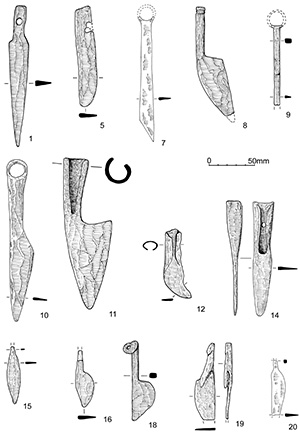
7. Knife, complete but in three pieces, with a scale tang, and a broken suspension loop. Straight cutting edge, with the back sharply angled down to the point. There is no obvious break between the blade and tang, which are the same width, but the tang must be relatively short, as an edge is still visible in the break nearest the loop. This is a knife of Manning's type 1a (1985a, 109), which he cites as an early type, commonest in the 1st century AD. L. 135mm, W. 15mm. SF3294, Fill 9488, Ditch 9496, Group 150, Area D, Period 2B
8. Variant of Manning type 8. The tip of the blade is missing but the rod handle is probably complete. It is sturdy, and non-tapering, with an oval or rectangular section, and two circumferential grooves at the end. There is mineralised wood on the tang, but it is unlikely to be part of the handle as its orientation is wrong. L. 125mm, tang section c. 9x7mm. SF6454, Fill 13800, Pit 13809, Group 397, Area J, Period 3
9. Knife, Manning type 4. This type has a narrow, parallel-sided blade with an integral handle with an end loop. Manning considered that they were probably razors, or scalpels (Manning 1985a, 110). Most of the end loop is missing, and most of the blade. The handle has a rectangular section. SF6739, Layer 13576, Group 600, Area I, Period 3B
10. Knife with a flat handle, terminating in a suspension loop. There are no rivet holes present. The edge of the loop may be thickened on the tang side. L. 186mm, max. W. 32mm W. of tang 16mm. SF3999, Fill 10362, Ditch 10538, Group 838, Area F, Period 5-6
11. Socketed small cleaver or knife, with mineralised wood in the socket. The back is angled down from the junction with the socket, a probable Early Roman feature in knives; for similar cleavers see Manning 1989, 123, type 6, although in the present case the handle would have been parallel to the blade. L. 166mm, max. blade W. 48mm. SF5797, Fill 11063, Ditch 11062, Group 145, Area N, Period 2
12. Small blade, resembling a miniature pruning hook with an open socket. The end of the socket is damaged, but the length may be complete. The tip of the hook is missing. Unlike pruning hooks, however, the convex (i.e. the outer) edge of the blade is the cutting edge, with a blunt internal edge. The shape of the blade is very similar to a post-medieval saddler's and harness maker's head knife (or heading knife) used for work such as cutting holes for buckle tongues, and which also has the cutting edge on the outside of the curve (Salaman 1986, 256 and fig. 9:7). L. 76mm. Fill 13844, Pit 13845, Group 611, Area I, Period 3
13. Not illustrated. Open socket, tapering to a thin, flat blade, broken where it begins to expand. The surviving part of the blade has no sharp edge. This is probably a knife, and probably Manning's type 22, which he notes as a rare form. Most examples are from London, although there are two from Baldock (Manning and Scott 1986, 155, nos 535-6). L. 93mm, max. W. of blade 15mm. SF2278, Fill 5536, Post-hole 5545, Group 435, Area J, Period 5
14. Socketed knife, with a slight constriction between the socket and the blade. The socket is open, and rather crudely made, with a single perforation. The point of the knife is rounded. There is mineralised wood in the socket, but too little survives for identification. L. 124mm, blade max. W. 21.5mm, socket max. W. 23mm. SF1939, Fill 4709, Pit 14127, Group 1167, Area K, not phased
15. Knife. A very small, thin, leaf-shaped blade, with a rectangular sectioned tang, set centrally. The tang was broken in antiquity. L. 59mm, max. W. 14mm. SF1941, Fill 4539, Pit 4698, Group 754, Area K, Period 2
16. A very small, roughly semi-circular, tanged blade. There are traces of a bone handle on the incomplete tang. Manning type 13. The type includes a number of small examples, but this is unusually small, verging on a miniature. The presence of a bone handle suggests that it is a functional object rather than a model, and it may have had a specialised function. Total L. 62mm, L. of blade 37mm, W. 19mm. SF6644, Fill 15515, Pit 15514, Group 696, Area M, Period 4
17. Not illustrated. Knife tang of constant rectangular section. Most of the blade was broken off in antiquity. L. 67mm, section 8x4mm. SF4157, Fill 4870. Pit 4913, Group 4016, Area K, Period 4
18. A small, almost semi-circular blade, with the end of the tang curled over. The object appears complete, and may be a specialised tool. L. 86mm, max. W. 25mm. SF1954, Layer 4689, Group 4019, Area K, Period 4-5
19. Small tanged knife with a straight back and a curved edge, point missing. The knife appears to be unfinished, with the tang not fully formed. The strip that formed the blank for the knife was slit at an angle to form the heel of the blade, and the tang then formed by rolling the strip over. However, this process was not completed, as the part of the tang at the blade end has not been hammered flat. The edge of the blade is chamfered on one face only. L. 85mm. Max. W. of blade 22mm. SF1813, Fill 4392, Pit 4429, Group 741, Area K, Period 5
20. Small tanged knife, point and end of tang missing. It has a straight back and a curved cutting edge, with the tang set centrally. L. 62mm, max. W. 16mm. The complete blade would have been c. 74mm long. SF7751, Fill 22051, Well 22210, Group 448, Area J, Period 6

21. Tanged knife, complete, with a spear-head shaped blade, edged on one side only. Manning type 16. L. 185mm, max. W. 19mm. Tang L. 85mm. SF6279, Cleaning layer 20007, Area L, Period 5-6
22. Knife blade with square-sectioned tang. It has a curved blade edge with the tip missing. L. 104mm, L. of tang 49mm, max. W. of blade 16mm. SF1936, Fill 4140, Pit 4139, Group 744, Area K, Period 6
23. Knife, Manning type 11a. The point of the triangular blade is missing. It has a straight tang in line with the back, set into a curved antler handle. Little of the surface survives, but it originally had a polygonal section, probably octagonal. L. 210mm, blade L. 120mm, blade W. 35mm, tang L. 38mm. SF4943, Fill 15006, Pit 15005, Group 701, Area M, Period 6
24. Not illustrated. The tang and a small part of the blade of a knife. The tang is in line with the back. The blade was broken in antiquity, and there is also modern damage to the edge, so that the width is incomplete. Overall L. 60mm, tang L. 37mm, blade W. >18mm. Layer 5401, Group 457, Area J, Period 5-6
25. Not illustrated. Fragment, probably part of a small knife with the start of the tang. Slightly curved lengthwise. L. 44mm, max. W. 21mm. SF2282, Cleaning layer 5543, Area J, Period 5-6
26. Not illustrated. Broken knife tang, with the start of the blade. L. 54mm, W. of blade 16mm. SF2333, Layer 6212, Group 574, Area H, Period 4-5
27. Tanged knife, in good condition. It has a parallel-sided blade with a straight cutting edge, the back dipping to the point. The back is thickened on one face only. This is probably an example of the fairly rare Manning type 17. L. 145mm, L. of tang 52mm, W. of blade 22mm. SF2537, Machining layer 11000, Area A, unstratified
28. Not illustrated. Knife blade, parallel sided, with point and most of tang missing. The point of the knife may have been deliberately cut off, as it stops in a straight line. L. 110mm, W. 13mm. SF776, Machining layer 4000, Area A, unstratified
29. Not illustrated. Knife, point missing. Straight-backed, with the back in line with the tang. Manning type 11. L. 137mm, max. blade W. 37mm. SF6983, Cleaning layer 11345, Area N, not phased
30. Cylindrical copper-alloy knife handle, one side missing, and the butt end damaged. The blade end is bevelled, as with Greep's 'London type' (1982), with the narrow iron blade broken flush with the end of the handle. The tube was filled with a lead-based solder. The butt end has an iron plug, which is possibly the end of the tang, but which appears to be separate. However, all details of the tang are hidden by the solder. L 43mm, Diam. 13.5mm. SF129, Cleaning layer 3501, Area W, Period 3
31. Bronze. One piece knife handle with an oval section and waisted end. It has groups of moulded circumferential lines, and a completely perforating longitudinal hole. It is in fairly poor condition. A layer of bright metal plating shows in places, probably tinning. XRF showed that the object was a heavily leaded bronze throughout. L.52mm, Diam. 11.5-13mm. SF305, Machining layer 4000, Area A, unstratified
32. Copper-alloy dog and hare handle with an iron blade. L. 68mm, max. W. 25. SF834, Machining layer 4000, Area A, unstratified
33. Copper alloy. A roughly semi-circular plate with a hollow-backed, D-shaped stem, other end broken. There is a slit in the edge on one side of the stem, extending halfway round the head. The slit contains iron corrosion, apparently an iron plate fixed to the head by a rivet. On the back, on the edge without the slit, and at the junction between the head and stem, are two lugs, with an iron axis bar. The object is reminiscent of the terminal of an object from Wroxeter (Bushe-Fox 1914, 14, no. 19). The latter object has a moulded lion at one end, with lugs below, and a crescentic terminal at the other. Like the Elms Farm object, it had an iron blade (now missing) hinged into the terminal, although there were no lugs at this end. It was interpreted as the handle of a tool combining two implements. If, like the Wroxeter example, the Elms Farm object had a further implement at the missing end, it could be seen as the Roman equivalent of a Swiss Army knife. L. 19mm, W. of head 14mm, W. of stem 5mm, Th. of plate and stem 4mm, max. Th. 10mm. SF4685, Machining layer 11000
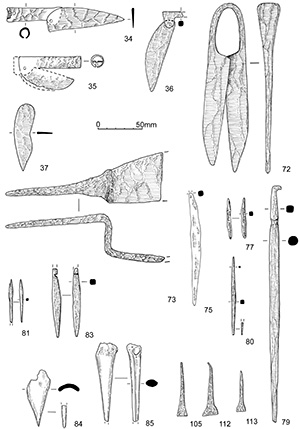
34. Socketed folding knife in two pieces, the socket (SF4164) and the blade (SF4163). There is recent damage to the socket, and the knife was obviously in one piece until excavation. The socket was made from a rectangular sheet with two semi-circular lugs at one end. The sheet was folded into a tube, with the edges almost butted, and the lugs were flattened to hold the blade, which was riveted on. Only one lug survives, but the shape of the second one is visible as a scar in the corrosion on the blade. There is a rivet through the base of the socket, to hold the missing handle. The outside of the socket has mineralised wood adhering, but this is probably not directly associated with the object. L. 136mm, blade L. 87mm, max. blade W. 28mm, socket L. 60mm. SF4163/4164, Cleaning layer 4881, Area K, not phased
35. Folding knife, in very poor condition, with the blade partly folded back against the iron handle ferrule. The socket has an internal diam. of 9mm, and has two opposed rivets visible near the end. There is a clear impression of the handle in the corrosion at the end of the socket, showing that it had a diameter c 3mm more than the internal diameter of the socket. There is a skin of mineralised wood in the socket, and the slit in the wood for the blade to slot into still survives. The ferrule is made from a sheet formed into a tube with the edges almost butted, as SF4163/4, with the end crimped to hold the butt end of the knife. The end of the tube and the lugs are missing, but the partial outline of one lug can be seen on the blade, round the pivot hole. The shape of the blade is clearer on the object than the X-ray, as the metal is very mineralised. Very little of the original edge survives, and the point and butt are damaged, but it probably had a straight edge and rounded back. L (folded) 69mm, max. external diam. of handle 13mm. SF5538, Fill 14093, Pit 14099, Group 4019, Area K, Period 4-5
This object is very similar to knife SF4163/4 (no. 34), and it transpires that part of the latter knife was found on top of Pit 14099. It is therefore almost certain that both came from the same pit.
36. Part of a folding knife, corroded onto a piece of tegula. The blade is complete, with a straight cutting edge and curved back. The handle, which is now at an angle to the blade, has two rounded lugs, flattened against the blade and pivoting on an iron rivet. Unlike the other folding knives from the site, the handle is tanged rather than socketed, but little of the tang survives. Blade L. 81mm, max. W. 21mm; lug W. 16mm, tang section 5x5mm. SF8466, Fill 8766, Pit 8745, Group 675, Area P, Period 5
37. Blade. The section is thin, with a curved back, and possibly the original point. The cutting edge is slightly scalloped. The butt end is complete as buried, and appears rounded, and possibly complete. This may be an unfinished blade from a folding knife, lacking its pivot hole. L. 74mm, max. W. 24mm. SF3567, Fill 5939, Pit 5940, Group 420, Area J, Period 4
38. Fragment, probably a rather blunt knife point, broken at the other end. L. 26mm, max. W. 7mm. SF6120, Fill 11340, Well 11341, Group 225, Area N, Period 4
39. Knife blade segment, with a pot rim corroded on, and a small globule of lead within the corrosion. L. 54mm, max. W. 18mm. SF2744, 5146, Pit 5147, Group 409, Area J, Period 3
40. Knife blade fragment, with a straight back and a rather rounded tip. L. 94mm, W. 16mm. SF6118, Fill 16230, Ditch 16231, Group 584, Area H, Period 6
41. Knife blade fragments, tang or socket missing. It has a straight back, with a regular taper to the point. L. 104mm, max. W. 20mm. SF1563, Layer 9264, Group 1302, Area D, not phased
42. Knife fragment; a narrow parallel-sided blade with a pointed tip, probably broken across a ring at the other end. Probably Manning type 1, possibly 1c. L. 112mm, W. 12mm. SF3179, Cleaning layer 5662, Area I, not phased
43. Knife blade point, with a fresh break. It has a straight edge and an angled back, as, for example, Manning type 4. L. 45mm, max. W. 16mm. SF4389, Cleaning layer 13028, Area I, not phased
44. Three joining strip fragments, probably a blade. The metal is very mineralised, and the edge is damaged. L. 74mm, max. W. 25mm. SF1183, Fill 4286, Pit 4285, Group 62, Area K, Period 2
45. The point from a large, thin blade, complete as buried. The surface is extensively covered in mineralised organic material, not directly associated with the object. The fragment is triangular, with a straight cutting edge. This large blade was probably a cleaver, similar to Manning Q103. L 178mm, W 82mm. SF2869, Fill 4521, Pit 4522, Group 275, Area K, Period 2
46. Blade fragment, fresh break. L. 28mm, W. 22mm. SF2819, Fill 7195, Pit 7221, Group 311, Area G, Period 2
47. Blade fragment, with a straight back, the edge curving evenly to the point. The tang or socket is completely missing. The blade is quite substantial, originally about 6mm across the back, and is probably from a heavy duty blade such as a chopper rather than an ordinary knife. L. 90mm, max. W. 32mm. SF6209, Fill 6828, Ditch 16018, Group 63, Area H, Period 2A
48. Probable blade fragment. The section is very thin, with neither side edged. One end has an old break, the other has an asymmetric point. The shape is right for a knife blade with a straight cutting edge, but it was either extremely blunt when buried, or is perhaps part of an unfinished implement. SF2118, Fill 5430, Pit 5431, Group 24, Area J, Period 2A
49. Fragment from the tip of a parallel-sided blade. The point is rather abrupt, with a ?broken tang at right-angles to the point. This is possibly part of a currier's slicker. See Manning 1985a, 39, E1-2 for two Late Iron Age examples. L. 37mm, W. 20mm. SF7870, Layer 20210, Group 113, Area L, Period 2B
50. Blade point, damaged. The break is very straight and sharp, and this was possibly cut in antiquity. Parallel sided, with an angled tip as Manning knife type 1c or 2. L. 69mm, W. 22mm. SF1979, Fill 4537, Pit 4536, Group 730, Area K, Period 3
51. Blade fragment, with fresh breaks. L. 43mm, max. W. 20mm. SF2795, Fill 8167, Well 8188, Group 788, Area E, Period 3
52. Socketed blade fragment, in two fragments, with the end of the socket and most of the blade missing. The back is straight and thick, 4mm. wide. L. 70mm, blade W. >32mm. In good condition. SF6919, Fill 8167, Well 8188, Group 788, Area E, Period 3
53. Blade fragment. L. 49mm, W. 17mm. SF7720, Fill 8537, Pit 8524, Group 656, Area P, Period 3
54. Two joining fragments of a parallel-sided blade. L. 73mm, W. 32mm. SF5201, Fill 10523, Ditch 10522, Group 360, Area F, Period 3
55. Blade fragment, in two pieces. 78x28mm. SF8298, Fill 13725, Pit 13824, Area I, Period 3
56. Blade fragment, fresh breaks either end. L. 40mm, W. 15-18mm. SF2122, Fill 10095, Pit 10094, Group 831, Area F, Period 4
57. Blade point, possibly part of SF7227, but damaged at the break, and with a clear cutting edge, unlike SF7227. The point is rather rounded. L. 76mm, W. 24mm. SF7225, Fill 11305, Pit 11304, Group 674, Area N, Period 4
58. Tanged blade with the tang set in line with the ?back of the blade. The end of the tang and the point are missing, and the blade is bent back on itself. There is no clear cutting edge, although Vanessa Fell notes that it is much damaged through corrosion. Blade W. 25mm, original L. c. 70mm, tang 20x9x3mm. SF7227, Fill 11305, Pit 11304, Group 674, Area N, Period 4
59. Blade fragment. L. 25mm, W. 20mm. SF8270, Fill 8153, Pit 8155, Group 836, Area E, Period 5
60. Fragment, possibly the point from a straight-backed blade. 52x28mm. SF8053, Layer 10255, Group 840, Area F, Period 5
61. Blade fragment with a thickened back, possibly part of a sickle. L. 43mm, W. 23mm. SF7700, Fill 10877, Pit 10910, Group 676, Area N, Period 5
62. Blade fragment, possibly with a slightly reinforced back. L. 47mm, W. 224mm. SF8217, Fill 5300, Pit 5282, Group 437, Area J, Period 5
63. Probable curved blade fragment, possibly part of a small pruning hook. L. 50mm, max. W. 18mm. SF3348, Fill 5864, Pit 5805, Group 444, Area J, Period 6
64. Fragment, probably the point of a blade. The section is triangular, although the 'edge' is now rather blunt. L. 45mm, max. W. 24mm. SF7724, Fill 9382, Ditch 9381, Group 834, Area D, Period 5-6
65. Open socket, most of the blade missing. The blade was probably single-sided. L. 64mm, socket W. 18mm, blade W. 18mm. SF3525, Layer 5809, Group 8003, Area J, not phased.
66. Blade fragment, from near the tip. L. 34mm, W. 16mm. SF432, Cleaning layer 6000, Area H, not phased.
67. Probable blade fragment, broken across the start of the tang. Blade edge damaged. L. 55mm, W. 35mm. SF500, Machining layer 7000, Area G.
68. Blade fragment, parallel-sided, with rather rounded tip. L. 112mm, W. 23mm. SF3302, Layer 9513, Group 1001, Area D, not phased
69. Two joining fragments, probably part of a blade. The tip may be rounded. L. 42mm, W. 23mm. SF5601, Cleaning layer 10682, Area F, not phased
70. Probable blade segment, parallel sided. L. 45mm, W. 21mm. SF764, Machining layer 4000, Area A, unstratified
Shears (Figure 545) seem curiously under-represented at Elms Farm, with only two pairs, neither of which is from a well-stratified context. However, it is difficult distinguishing between fragments of shear blades and knife blades.
71. Not illustrated. Part of a pair of shears. Half the blade is missing, and the handle is broken below the loop. L. 75mm, blade W. 18mm. SF383, Machining layer 4000, Area A, unstratified
72. A pair of shears, in three pieces. The basic shape is not unusual for Roman shears, although the handle on this example is unusually short. L. 182mm, handle L. 48mm. SF5133, Cleaning layer 5597, Area I, not phased
One definite and one possible trowel were found (Figure 545). Neither is complete enough to be certain of its original shape.
73. Tanged trowel, blade incomplete. The blade was probably a narrow leaf-shape (Manning type IV; Manning 1976, 27), and would probably have been used for fine plasterwork. The vertical between the blade and tang is broad, being a simple continuation of the blade bent at right angles. SF7419, Fill 15857, Pit 15856, Group 698, Area M, Period 5
74. Not illustrated. Tanged object, with part of a ?blade at right-angles. This is probably a trowel tang, broken at the top of the vertical element of the tang, and also across the beginning of the blade. The bottom of the tang broadens slightly. L. 65mm, max. W. of tang 16mm. Layer 10492, Group 838, Area F, Period 5-6
Two types of iron awl were present on the site (Figure 545), those designed to be inserted into wood or bone handles, normally tapering at both ends, and those with broader butts that may have been used without a separate handle. Awls are a particularly difficult tool to recognise, as the larger examples resemble drill bits, and incomplete examples may simply look like nail fragments. Examples with pointed tips are probably leatherworkers' awls, while those with chisel tips are carpenters' bradawls. Of the nine definite or probable awls, two are bradawls, and the remainder probably leatherworking awls.
75. Awl, tapering either end, with a ?rounded tip, other end broken. Comparable to Manning 1985a, E14, although the Elms Farm example appears to have a rectangular section rather than the more usual square section. L. 128mm, max. W. 11mm. SF7516, Layer 20303, Group 113, Area L, Period 2B
76. Not illustrated. Awl or small drill bit, probably with a square section throughout. The tip is bent. L. 68mm, max. W. 5mm. Fill 14022, Pit 14098, Group 4019, Area K, Period 4-5
77. Small tanged ?bradawl. Rectangular section with a chisel point of the same width, and a short tang. L. 45mm, section 4x3mm, tang L. 9mm. SF1640, Fill 6117, Pit 6127, Group 577, Area H, Period 5
78. Not illustrated. Probable awl. Rod, section unknown, with one end pointed, the other broken in antiquity. The shaft is swollen. L. 67mm, max. W. 4mm. Cleaning layer 5305, Area J, Period 5-6
79. Large awl, circular section. One end tapers to a blunt point. The other end is square in section, with a constriction 36mm from the end. The tip is turned at right angles. Manning type 4b, similar to Manning E12. L. 272mm, max. W. 12mm. SF1096, Machining layer 7000, Area G
80. Awl, with a square section, tapering to a point at one end and with a very narrow chisel point at the other. The latter feature identifies it as a carpenter's bradawl rather than a leatherworker's awl. L. 89mm, max. W. mm. Layer 7073, Group 1319, Area G, not phased
81. Small awl or drill bit. Rectangular sectioned, swollen shaft, tip missing. L. 48mm. Unknown context 13801, Area J, not dated
82. Not illustrated. Small bar, tapering at both ends, completeness uncertain. This might be a small awl. L. 36mm, max. section 3x3mm. SF6455, Unknown context 13801, Area J, not dated
83. Tool, probably an awl, with the very tip missing and the butt probably incomplete. It has a notch with a V-shaped profile across one face at the butt end. The section is rectangular, possibly slightly rounded in the middle. Machining layer 2000, Area W, unstratified
Two bone awls (see Figure 545) were identified, one belonging to Danebury Class 2 (SF8397), and one to Danebury Class 4 (SF6833) (Sellwood 1984, 389). Although their form is consistent with use as boring implements, their precise function is unknown. They were possibly used in leather-working, although they do not appear to be robust enough to pierce leather of any thickness.
84. Awl, made from a pointed splinter of a large mammal long bone. Slight damage to the butt, surface eroded. L. 65mm, W. 21mm. SF6833, 4692, Slot 4695, Group 1161, Area K, not phased
85. An ?awl, made from a horse fibula. Complete bar the point. The surface is in fair condition, with no definite sign of wear, so this may not have been used. L. 89mm, Diam. 24mm tapering to 7mm. SF8397, Layer 6959, Group 484, Area H, Period 3
Chisels are the most common tool type recognised on the site, with forty-three examples. Twenty-eight of these are definite or probable 'simple' chisels, as Manning B43 and B44. These have short tangs, usually with a square section, and small triangular or semicircular blades, often bevelled on one face only. The type was undoubtedly far more common, as broken simple chisel tangs are indistinguishable from nail shafts. Some of the broken blades could possibly be styli, but where the tang section is clearly square, it has been assumed to be a chisel. The 'simple' chisels can be Iron Age or Roman, but there are only two examples from Iron Age contexts at Elms Farm.
The other chisels include several hot chisels, for use in iron working, as well as socketed and tanged carpenters' chisels.
86. Not illustrated. Probably a simple chisel with the blade bent at right angles to the tang. L. 48mm, L. unbent 67mm, blade W. 11mm. SF5430, Fill 14002, Post-hole 14057, Group 92, Area K, Period 2
87. Not illustrated. Possible small simple chisel blade, the shank slightly bent, and broken in antiquity. It has a narrow triangular blade. L. 23mm, blade W. 6mm. Fill 2264, Ditch 2265, Group 10, Area W, Period 2A
88. Not illustrated. Probable simple chisel. In two pieces, tang incomplete. L. 52mm, blade W. 17mm. Layer 5936, Group 606, Area I, Period 3B
89. Not illustrated. Simple chisel, broken square-sectioned tang. Quite a chunky little chisel. L. 40mm, blade W. 21mm. Layer 6121, Group 556, Area H, Period 4
90. Not illustrated. Simple chisel, shaft broken. L. 42mm, blade W. 16mm. Layer 6142, Group 543, Area H, Period 4
91. Not illustrated. Probable small, tanged chisel, with a slightly splayed, rather elongated blade. Probably incomplete. Square-sectioned tang, blade W. c. 8mm, L. 73mm. Layer 21908, Group 423, Area J, Period 4
92. Not illustrated. Simple chisel, complete. L. 45mm, blade W. 9mm. Fill 14093, Pit 14099, Group 4019, Area K, Period 4-5
93. Not illustrated. Possible distorted simple chisel. The shaft is complete and bent, with the head curved back on itself. The head is clearly flattened, and probably flared, although no details are visible on the X-ray. L. 49mm, head W. c. 14mm. Fill 5229, Post-hole 5232, Group 427, Area J, Period 4-6
94. Not illustrated. Possible simple chisel, with a rather narrow inverted triangular head. The shank is curved, and was broken in antiquity. L. 43mm, head W. 8mm. Fill 5472, Ditch 5473, Group 436, Area J, Period 5
95. Not illustrated. Two possible simple chisels, with the heads bent over. a) incomplete shaft, L. 33mm, head W. 16mm b) complete. L. 47mm, head W. 15mm. Fill 10502, Pit 10504, Group 846, Area F, Period 4
96. Not illustrated. Probable simple chisel. The point of the tang is missing, and the blade probably incomplete. L. 58mm, blade W. 16mm. Fill 11139, Pit 10910, Group 676, Area N, Period 5
97. Not illustrated. Possible simple chisel, with the tip of the tang missing. L. 40mm, W. of blade 9mm. Cleaning layer 5543, Area J, Period 5-6
98. Not illustrated. Possible simple chisel. It resembles a slightly flaring stylus eraser, but the broken shaft has a square section, so it is more likely to be a chisel. L. 38mm, W. of blade 7mm. Fill 5864, Pit 5805, Group 444, Area J, Period 6
99. Not illustrated. Probable simple chisel head. L. 53mm, head W. 14mm. SF3327, Fill 5864, Pit 5805, Group 444, Area J, Period 6
100. Not illustrated. Possible simple chisel blade. A very blunt triangular blade with a short tang, probably broken in antiquity. L. 38mm, blade W. 17mm. Dump 6786, Group 586, Area H, Period 5-6
101. Not illustrated. Probable simple chisel with the blade bent back on itself and the shank distorted. L. 50mm, max. W. 16mm. Fill 14635, Pit 14632, Group 722, Area L, Period 6
102. Not illustrated. Simple chisel, with a roughly semi-circular blade, curved edge to the tang. The edge is incomplete and damaged. Cf. Manning 1985a, 24, nos B43 and B44. SF6648, Layer 15462, Group 751, Area M, Period 5-6
103. Not illustrated. Simple chisel, with incomplete square shaft. L. 52mm, W. of blade 20mm. SF838, Machining layer 4000, Area A, unstratified
104. Not illustrated. Simple chisel, with the end of the tang and one corner of the blade missing. The blade is triangular, with slightly rounded sides. L. 53mm, original blade W. c. 20mm. SF6595, Machining layer 4000, Area A, unstratified
105. Small simple chisel, as Manning 1985a, B43/44. L. 62mm, blade W. 12mm. SF8213, Machining layer 4000, Area A, unstratified
106. Not illustrated. Small simple chisel, with the end of the tang missing. L. 33mm, blade W. 8mm. Fill 4842, Pit 4843, Group 1147, Area K, not phased
107. Not illustrated. Simple chisel. The blade is relatively elongated for the type, although still an inverted triangle, with very slight shoulders onto the tang. Complete. L. 45mm, blade L. 20mm, W. 9mm. Machining layer 7000, Area G, Not phased
108. Not illustrated. Simple chisel. The edge of the blade is bevelled and the tang incomplete. L. 43mm, blade W. 15mm. Machining layer 7000, Area G, Not phased
109. Not illustrated. Possible simple chisel. The shaft is broken, and the head flattened into a small, rounded blade. L. 43mm, head W. 10mm. Cleaning layer 10242, Area F, not phased
110. Not illustrated. Simple chisel. A small triangular blade with 2mm of the edge turned at right angles. The end of the tang is missing. L. 49mm, blade W. 12mm. SF5242, Cleaning layer 10506, Area F, not phased
111. Not illustrated. Probable simple chisel, with the head bent over. L. 50mm, blade W. 17mm. Cleaning layer 10978, Area N, not phased
112. Simple chisel, complete, with the end of the tang bent. L. 61mm, blade W. 16mm. Cleaning layer 23002, Area N, not dated (Figure 545)
113. Simple chisel, with a D-shaped blade, bevelled on one face only. Complete. L. 45mm, blade W. 11mm. Cleaning layer 24058, Area M, not phased (Figure 545)
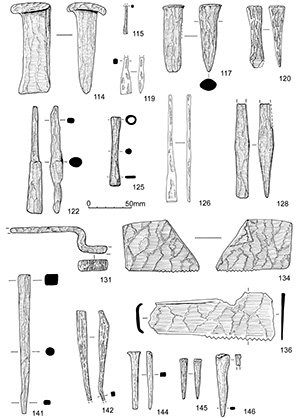
114. Chisel or wedge. The edge is slightly splayed and somewhat blunt. The top is burred on three sides. L. 108mm, section c. 33x22mm. SF6668, Fill 15290, Pit 15573, Group 691, Area M, Period 3
115. Rod, with a circular section and a slightly flared, flattened terminal, other end broken. This is probably a simple tool of the type described at Danebury as a chisel made from a small iron rod (Sellwood 1984, 354, nos 2.60-2.62). It differs from the simple chisels listed above in that the tang has a circular section. L. 34mm, blade W. 6mm. SF6119, Fill 15612, Pit 15641, Group 240, Area M, Period 2B
116. Not illustrated. Bar with closed socket, end of bar broken. Probably a chisel, cf Manning B36. L. 90mm, max. socket Diam. 18mm, bar W. 17mm, Th. 2.5mm. SF902, Layer 6053, Group 506, Area H, Period 3
117. Chisel or punch. Oval section, with a burred head and a broad wedge point. L. 84mm, section c. 18x18mm. SF1061, Layer 5494, Group 631, Area I, Period 3B
118. Not illustrated. Bar fragment, one end broken in antiquity and slightly bent. The other end is bevelled. Probably a damaged chisel blade. L. 48mm, W. 11mm, Th. 7mm. SF3288, Fill 9344, Gully 9343, Group 3063, Area D, Period 3-4
119. Probable small chisel with a triangular blade, which Vanessa Fell notes is worn. The short tang is possibly incomplete. L. 44mm, blade W. 14mm. SF7638, Spread 10289, Group 820, Area F, Period 4
120. A small hot chisel. The short, solid handle has a circular top, diam. 18mm, tapering fairly abruptly to a slightly splayed blade, tip damaged in antiquity. L. 70mm, blade W. 17mm. SF2751, Layer 6238, Group 574, Area H, Period 4-5
121. Not illustrated. Chisel blade or wedge. The thin end is slightly splayed, and was damaged in antiquity, making it impossible to say whether the edge was bevelled. In good condition, and apparently complete as buried. L. 60mm, W. 13mm, max. Th. 15mm. SF4647, Fill 10502, Pit 10504, Group 846, Area F, Period 4
122. Chisel, probably a tanged paring chisel, with a bolster between the blade and the tang. Cf. Manning 1976, 25 no. 59. L. 128mm. SF3209, Make-up layer 5499, Group 434, Area H, Period 5
123. Not illustrated. Socketed object. It has a narrow, closed socket, gaping slightly along the seam, and a broken shank with a rectangular section. This is probably a chisel, with the blade missing. Overall L. 76mm, socket L. 45mm, diam. 12mm, shank section 9x6mm. Fill 5214, Pit 5209, Group 442, Area J, Period 6
124. Not illustrated. Socketed bar, with fresh break. There may be mineralised wood present in the open socket. Probably part of a socketed chisel. Socket L. 47mm, diam. 20mm; bar diam. 7mm. Overall L. 145mm. SF894, Layer 6025, Group 573, Area H, Period 5-6
125. Chisel, with a closed socket, slightly damaged but with a complete length. The blade is slightly splayed. L. 80mm, W. of blade 14mm, diam. of socket 12mm. SF1771, Cleaning layer 5228, Area J, Period 5-6
126. Chisel. A square sectioned tang and rectangular sectioned blade with a chamfered end. A carpenter's paring chisel, similar to Manning B30. L. 124mm, W. 13mm. SF7239, Layer 15613, Group 6009, Area M, Period 6
127. Not illustrated. Tanged chisel with a slightly flared point, probably bevelled. Cf. Manning B30. L. 93mm, W. of blade 17mm. SF1428, Machining layer 4000, Area A, unstratified
128. Chisel, head probably burred. It has a thin, parallel-sided blade, with an expansion in the middle of the shank. Manning suggests that this form is a hot chisel, cf. Manning 1985a, A21. L. 112mm, W. 15mm, max. Th. 16mm. SF5691, Machining layer 11000, Area A, unstratified
There was only one definite drill bit identified, a small fragment of a spoon bit from a Period 4-5 context. A second fragment, from a Period 5-6 layer is possibly the stem of a drill bit.
129. Not illustrated. Possible drill bit, both ends broken. The broader end is probably starting to narrow again, suggesting that this is not just a nail shaft. L. 109mm. SF875, Layer 6008, Area H, Period 5-6
130. Not illustrated. Spoon bit, stem missing. It is possible that one of the 'nail shafts' from the context is part of this object, but the break is ancient, and although it was corroded onto several other pieces of iron, none of them joined. Oval, L. 29mm, W. 10mm. Fill 14093, Pit 14099, Group 4019, Area K, Period 4-5
131. File, with cranked tang. The tang has a fresh break, the blade an ancient one. The blade has a rectangular section, and the teeth are single cut and raked, with 5.5 teeth to the centimetre. The file is thus coarse cut, suggesting that it may be a carpenter's float rather than a metalworking file (cf. Manning B79). L. 104mm, L. of blade 31mm, section 11x9mm. SF404, Fill 4142, Pit 4141, Group 1147, Area K, unphased (Figure 546)
132. Not illustrated. Gouge, with a solid, circular-sectioned handle of constant diameter with a slightly burred head. The U-shaped tip is incomplete. L. 79mm, Diam. 9mm. SF1159, Fill 4129, Pit 4128, Group 744, Area K, Period 6
133. Not illustrated. Bar fragment, probably part of a gouge. The end is flattened, with a very shallow curve. L. 39mm, W. 7mm. Cleaning layer 14201, Area L, not phased
134. Saw blade fragment in two pieces, from a fairly wide handsaw. There are no teeth visible for the first 24mm, so this is presumably from near the handle end, although there are no perforations present. The teeth are slightly raked, but not set, with c. 3 teeth per cm. One corner of the back is turned over. L. 90mm, W. 59mm. SF4718, Fill 13290, Pit 13358, Group 645, Area I, Period 5 (Figure 546)
135. Not illustrated. A small fragment from a saw blade, with four teeth present, probably not set. The teeth are symmetrical, which Manning (1985a, 21) suggests marks it as a bow saw. L. 18mm, W. 21mm. SF8315, 16270, Hearth construction 16273, Group 587, Area H, Period 6
136. Handsaw fragment, in two joining pieces, broken in antiquity. It has rather irregular teeth, which are not set, with 2.5 teeth to 2cm. The handle has a low flange along each edge. There are no definite nail holes, but the metal is very mineralised and patchy on the X-ray. L. 144mm, W. 53mm. SF7349/6139 Fill 20063, P it 20066, Group 707, Area L, Period 3 (Figure 546)
Thirty-three objects were identified as definite or probable punches (Figure 546 and Figure 547). Some of the bar fragments in function category 20 may well be punches, but are too incomplete to be certain.
137. Not illustrated. Bar, complete as buried. It has a variable rectangular section, tapering to a blunt point at one end. The other end also tapers slightly, and is rounded. It is probably a tool, and possibly a punch, although not as symmetrical as most examples. If it is a punch, it does not appear to have been used. L. 57mm, max. section 13x12mm. Fill 20488, Pit 20481, Group 42, Area L, Period 2A
138. Not illustrated. Possible punch. Tapering circular-sectioned bar with a blunt point and a rounded head. L. 62mm, max. diam. 17mm. SF8306, Fill 15288, Pit 15289, Group 239, Area M, Period 2B
139. Not illustrated. Punch, with a slightly flattened head. The section is probably circular throughout. The blunt point is complete, and has a slight bevel on one side. L. 102mm, max. Diam. 18mm. SF6147, Fill 15590, Pit 15591, Group 238, Area M, Period 2B
140. Not illustrated. Punch or wedge with a slightly burred head. The head is also slightly domed, though this may be a product of corrosion. The width is almost constant. It is in poor condition, with the blade fissured. L. 77mm, W. 18-20mm, max. th. 15mm. Fill 8825, Pit 19176, Group 663, Area P, Period 3
141. Probable punch. A variable sectioned spike, with a square, unburred head. The section becomes more rounded towards the middle. The point is slightly skewed. The very tip may have broken off in antiquity. L. 162mm, max. W. 14mm. SF3315, Context 5798, Hearth construction 5692, Group 3015, Area J, Period 3B
142. Probable punch. Bar with a variable rectangular section, thickest just below the head. The head is narrow, and slightly burred. The point is blunt, and slightly bent. The tip is damaged, but was probably pointed. L. 107mm, max. section 12x12mm. SF3535, Fill 13196, Gully 13242, Group 615, Area I, Period 3B
143. Not illustrated. Punch. The head is slightly expanded, and slightly domed. The stem has a circular section, with a blunt tip in poor condition. The tip appears to be slightly distorted, possibly damaged during use. SF4941, Fill 9796, Pit 9750, Group 784, Area D, Period 3B
144. Punch, with the head slightly expanded on the sides only. L. 66mm, blade W. 6mm. Fill 4954, Pit 4943, Group 739, Area K, Period 4
145. Small punch, probably complete, with a rectangular section, becoming oval towards the wedge point. The head is slightly burred. This simple type of punch closely resembles a nail shaft, and without cleaning, would have been indistinguishable from one. It is possible that many of the 'nail shafts' identified were simple small tools like this example. L. 48mm, max. section 9x7mm, blade W. 4mm. SF7292, Fill 10088, Pit 10089, Group 830, Area F, Period 4
146. A tapering bar, complete as buried, with a slightly burred head and a blunt point. This is probably a punch, though unusually flat for one. L. 73mm, max. section 17x7mm. SF2186, Layer 10104, Group 813, Area F, Period 4
147. Not illustrated. Bar fragment, probably a punch rather than a nail shaft. The section is rectangular rather than square, and the X-ray shows a rounded tip which appears original, and which bulges slightly on one side. The head end of the bar tapers slightly, but there is no sign of burring on the top. There is a fleck of ?lead in the corrosion. L. 67mm, section towards tip 7x5mm, max. W. 7mm. Fill 12036, Ditch 12027, Group 968, Area R, Period 4-5
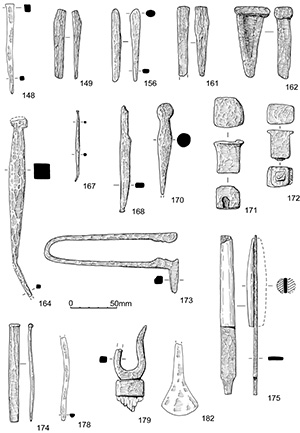
148. Punch or awl with an irregular, burred, flat head. The section is rectangular to square, and the tip is twisted. This may be the result of damage in use rather than deliberate (Vanessa Fell). L. 96mm, max. section 11x9mm. SF5991, Fill 16182, Robber trench 16197, Group 567, Area H, Period 5
149. Smith's punch or chisel, as Manning A24. It has a rectangular section of constant width and variable thickness. The head is bent to one side, and split, possibly due to damage in antiquity, which might have lead to the discarding of the tool. L. 74mm, W. 11mm, max. Th. 8mm. SF5361, Cleaning layer 5307, Area J, Period 5-6
150. Not illustrated. Probable punch. Tapering bar, probably with a rounded point, now damaged. The widest part is c. 10mm below the head, which is flat. The section is uncertain, probably rectangular or oval. L. 87mm, max. section c. 17x15mm. Layer 6025, Group 573, Area H, Period 5-6
151. Not illustrated. Tapering bar, probably a punch. Possibly complete, and tapering in two dimensions to a point with a bevel on one face. Cf. Manning A28. L. 62mm, max. section 23x17mm. SF2800, Layer 6025, Group 573, Area H, Period 5-6
152. Not illustrated. A probable small punch with an oval or rectangular section, and a slightly burred head. L. 50mm, max. section 10x7mm. SF6130, Fill 8638, Pit 8637, Group 678, Area P, Period 6
153. Not illustrated. Probable small punch. A bar with a slightly rounded section, with little taper. The head may be slightly burred, with a rather blunt chisel edge at the other end. L. 46mm, max. W. 9mm. Layer 15897, Group 146, Area M, Period 6
154. Not illustrated. Punch? A tapering bar with a rectangular section, possibly changing to a circular section near the point. L 74mm, max. section 10x6mm. SF8028, Fill 24071, Ditch 24070, Group 146, Area M, Period 2B-6
155. Not illustrated. Fragment, probably the head from a punch. It is badly flaked and incomplete, and probably has a round head. Cleaning layer 4757, Area K, not phased
156. Bar, variable section, complete as buried. One end has a square section, and tapers to a bluntly rounded end. The section is sub-circular towards the other end, which is slightly conical. This is probably a rather crudely made punch or similar tool, although there is no sign of burring to the head. In poor condition, flaking. L. 81mm, section c. 9x5mm - 12x11mm. Fill 4994, Pit 4989, Group 1147, Area K, not phased
157. Not illustrated. Punch, covered in hard concretion. It has a rounded, pointed tip. The head may be broken; there is no burring evident on the X-ray. The section is uncertain, but may be polygonal at the head end. L. 68mm, max. W. 12mm. SF3389, Cleaning layer 6515, Area H, not phased
158. Not illustrated. Probable punch, with the head probably complete, though with no trace of burring, and the other end damaged. It probably tapered abruptly to a point. Section uncertain. L. 81mm, W. 14mm. SF854, Cleaning layer 6000, Area H, not phased
159. Not illustrated. Rod. One end was probably broken in antiquity, the other end is slightly splayed and slightly flattened, with a straight edge, 11mm wide and 4mm thick (i.e. there is no blade edge). This edge appears to be original. This is probably a punch, although it lacks the swelling of the shaft normally found on such tools. L. 72mm, ?square section, W. 7mm. Fill 7447, Gully 7454, Group 1349, Area G, not phased
160. Not illustrated. Probably a small punch, though this could be a wedge. The head has a suggestion of burring, although the metal is badly fissured, and this end may not be complete. The other end has a blunt point. Max. section 18x15mm, L. 52mm. SF3298, Layer 9510, Group 1301, Area D, not phased
161. Punch or chisel. A bar, tapering to a wedged blade, broken or blunted in antiquity. The head is probably slightly burred, with a slight bulge below it. L. 77mm, max. section 15x13mm. SF2231, Cleaning layer 10250, Area F, not phased
162. Punch, with a burred head, tip missing. The section is rectangular, and the faces are slightly hollowed. L. 75mm, max. section 36x18mm. SF2584, Machining layer 11000, Area A, unstratified
163. Not illustrated. Punch or chisel fragment with a rectangular section. A tapering bar, broken in antiquity at both ends. L. 75mm, max. section 14x10mm. SF5277, Machining layer 11000, Area A, unstratified
164. Smith's punch, with a circular button head, now damaged, and a swollen handle. The point is bent and the tip is missing. The section is square throughout. There is a similar tool from Gestingthorpe (Manning 1985b, 46, no. 159). L. 195mm, Diam. of head 18mm, max. W. of handle 18mm. SF5705, Machining layer 11000, Area A, unstratified
165. Not illustrated. Bar fragment with a slightly rounded tip, the other end broken in antiquity. The section is rounded towards the tip, becoming squarer at the broken end. Probably a punch. L. 87mm, section W. 9mm. Machining layer 12000, Area R, unstratified
166. Not illustrated. Bar fragment, with a slightly rounded, tapering section, the point missing. Probably a small metalworking punch. L. 36mm, max. section 14x13mm. Machining layer 12000, Area R, unstratified
167. A small tool, probably a delicate punch rather than an awl, as the point is very blunt. The shaft is thicker in the middle, with a square section at one end and a round section at the other. The top has a small square button, possible incomplete. The tip is bent. L. 76m, max. W. 5mm. Cleaning layer 14609, Area L, not phased
168. Bar with a variable rectangular section with two steps towards one end. The other end is burred. This is probably a punch. L. 117mm, max. section 12x6mm. SF7341, Cleaning layer 20016, Area L, not phased
169. Not illustrated. Punch or chisel, with a broad blade of constant width and rectangular section, and a burred head. Probably a smith's punch. L 65mm, section 16x10mm. SF7894, Cleaning layer 23033, Area N, not phased
Drifts (Figure 547) were used by smiths for enlarging holes, and are similar to punches, but have swollen shafts. Manning (1985a, 10) notes that Roman drifts as such are very rare, and that punches were probably used for the same purpose as the modern drift.
170. Tool, probably a drift. The section is probably circular throughout, with a pointed end, swollen shank and a bulbous head. The head does not show any sign of having been hit, so this was possibly unused, or very little used. L. 109mm, head diam. 19mm, max. diam. of shank 16mm. SF2383, Layer 6316, Group 547, Area H, Period 4
171. Block with a sub-rectangular section. The top is burred, and the base has a shallow rectangular groove c. 1.5mm deep, extending from one edge to halfway across the bottom. The object appears complete, and sits squarely on the base. Possibly a small anvil. Ht 34.5mm, section 25x28.5mm. SF3290, Cleaning layer 9454, Area D, not phased
172. Metalworking die? A rectangular block with a flat 'head' protruding on two sides only. The other end has a stepped square projection in the middle. The higher area is irregular, but may have originally been square. 'Top' 28x22mm, section 18x21mm, L. 33mm. SF3330, Pit 5805, Group 444, Area J, Period 6
173. Combination swage and former. The object was identified by D. Dungworth, who does not know of any other Roman examples. It resembles a U-shaped drop-hinge, with a spike pointing outwards on one side at the open end. The other terminal has a flat base. The inner faces at the open end have a complex, curved profile, one the negative of the other. The spike would have been mounted in a block of wood or other material, and the shaped inner edges used as a die to stamp sheet metal. L. 147mm, W. 35mm, rectangular section 12x4mm, narrowing slightly towards the terminals. SF3467, Spread 10289, Group 820, Area F, Period 4
174. Tool, probably a tracer. A thin bar with a uniform rectangular section and a burred head. The tip is slightly rounded. Tracers were used for producing outline decoration. L. 108mm, Section 10x3mm. SF1310, Layer 5275, Group 457, Area J, Period 5-6
175. Tool? The object is a flat bar of constant width, narrowing at the tip to a blunt point, which may be incomplete. The other end is flattened, and probably protrudes beyond the end of the handle. The object has a two-piece wooden handle with an oval section. It is not clear how the handle is attached, as there are no signs of rivets, and it may have been held in place by bands of metal, or was possibly bound with twine. This could have been a double-ended tool, with a punch at one end and a chisel-like blade at the other. L. 176mm, max. W. 17mm. SF7413, Fill 15420, Pit 15417, Group 33, Area M, Period 2 (Figure 547)
176. Not illustrated. Small bar fragment with a slightly flared wedge point. Probably a tool. L. 27mm, section 9x7mm. SF5359, Prepared surface 13063, Group 365, Area I, Period 3
177. Not illustrated. Wedge or tool point, of constant width. The top shows no signs of use, and may be incomplete. L. 43mm, max. section 16x15mm. SF8227, Make-up layer 7636, Group 854, Area G, Period 3-4
178. Narrow bar with a rectangular section, bent. One end is probably broken, and the other has a rounded tip, possibly spoon-shaped. This is almost certainly a tool tip, perhaps a metalworking tool such as a tracer (Manning 1985a, 11, A33), or the tip of a drill bit (Manning 1985a, 26, B53), or even a bradawl (Manning 1985a, 28, B77). L. 92mm, section 4x3mm. SF7655, Cleaning layer, Area J, Period 3B
179. Tanged fork, with traces of the wooden handle. The end of the handle was bound by a cylindrical ferrule. The tip of one prong is missing. Mineralised wood is present, almost certainly ash. There is no evidence that the Romans used forks for eating, so this is presumably a tool. It is surely too small to be a pitchfork, although the claimed Roman pitchfork (an unstratified find) from Rushall Down, Wilts, is only 105mm long (Rees 1979, 483). L. 82mm, Diam. of ferrule 32mm. SF2332, Layer 6253, Group 4008, Area H, Period 4
180. Not illustrated. Probable tool tang. There is bone on the surface, probably traces of a handle. L. 78mm, section c. 7x7mm. Fill 10262, Pit 10271, Area F, Period 4
181. Not illustrated. Bar, probably a tool or knife tang. At least one end is broken. It has mineralised bone on the surface, most likely horn, which is probably the remains of the handle. L. 47mm, W. 10mm. Fill 6117, Pit 6127, Group 577, Area H, Period 5
182. Tanged tool. The incomplete tang is set centrally on a short, oblique-shouldered blade with a ?curved edge. The section is quite thick, with the top of the blade being thicker than the tang. This is possibly a barking iron (or barking spud), used for removing bark for use in tanning. It is very similar in shape and size to the blades of post-medieval barking irons, illustrated by Salaman (1986, 299). L. 87mm, W. of blade 39mm. SF5989, Fill 16163, Foundation trench 16196, Group 567, Area H, Period 5
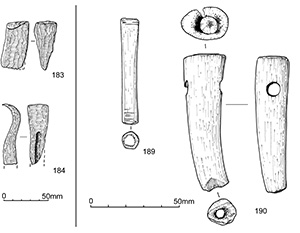
183. Wedge-shaped fragment. The surfaces are flaked, and it may not be complete; it could be the point from a chisel or other tool. The blade could be serrated; the X-ray shows three nicks at regular intervals, although this may be an illusion created by the corrosion. L. 54mm, max. section 25x25mm. SF2798, Cleaning layer 5543, Area J, Period 5-6
184. Probable socketed scraper, with a short curved blade. The socket is broken, and the edge of the blade damaged or chamfered. There are a number of parallels, including a larger example from Lullingstone (Meates 1987, 98, no. 256, unstratified), one of similar size but with a shorter blade from a 4th-century context at Uley (Woodward and Leach 1993, 196 no. 8), and two from Ivy Chimneys, Witham, Essex (Major 1999b, 99, nos 17 and 20). One of the latter had small teeth at the end of the blade, and came from a late 3rd-early 4th-century context; the other was unstratified. L. 70mm, W. of blade 26mm. SF882, Layer 6008, Group 590, Area H, Period 5-6
185. Not illustrated. Tube, probably part of a slightly tapering closed socket from a knife or tool. Both ends broken in antiquity. L. 58mm, diam. 14mm, tapering to 12x10mm. SF2337, Layer 6227, Group 573, Area H, Period 5-6
186. Not illustrated. Probable small tool. It resembles a simple chisel, but the blade is very short, and set at an obtuse angle to the tang, the very tip of which is missing. The X-ray appears to show a quite sharp edge to the blade. This may be a bent chisel, or the angle at which the blade is set may be deliberate, in which case this may be a small scraper. L. 52mm, 'blade' W. 13mm. Cleaning layer 4683, Area K, not phased
187. Not illustrated. Probable tool tang. A square-sectioned pointed bar, with a fresh break at the other end. The section becomes rectangular and much thicker just before the break. L. 57mm, max. section 17x9mm. Cleaning layer 10682, Area F, not phased
188. Not illustrated. Tool tang, possibly from a chisel, broken at the start of the blade. L. 57mm, max. section 8x7mm. Machining layer 11000, Area A, unstratified
189. A small tool handle? A very smooth, animal bone shaft, with the core removed and one end smoothed internally to take the end cap. A slightly smaller example was found in a 2nd-century ditch at Gorehambury, Herts (Wardle 1990, 158). SF4903, Fill 9497, Ditch 9496, Group 150, Area D, Period 2B (Figure 548)
190. A tool handle? A curved and slightly tapering section of long bone. The cancellous bone at the broader end of the object has been carefully replaced by a small peg and rounded off. A hole 8mm in diameter has been drilled through the broader end. Incomplete. SF7835, 23025, Pit 23024, Group 906, Area N, Period 3 (Figure 548)
Twelve iron tools had traces of the handle surviving, summarised in Table 112. As might be expected, all the socketed tools had traces of wooden handles. The tanged tools variously had wood, antler, or bone handles. Horn handles may also have been present, although the survival was too poor to be able to identify it conclusively. The condition of most of the wood was too poor for identification.
| Material | No. | |
|---|---|---|
| Wood | 6 | Socketed knife (SF1939, 4709, Group 1167) Socketed cleaver or knife (SF5797, 11063, Group 145) Socketed folding knife (SF5538, 14093, Group 4019) Socketed blade (SF2765, 5543, Group 457) Tanged fork; ash (SF2332, 6253, Group 4008) Scale tang tool; (SF7413, 15420, Group 33) |
| Wood? | 1 | Socketed chisel? (SF894, 6025, Group 573) |
| Wood or horn | 1 | Scale tang knife (SF3491, 10320, Group 828) |
| Antler | 1 | Whittle tang knife (SF4943, 15006, Group 701) |
| Bone | 1 | Whittle tang knife (SF6644, 15515, Group 696) |
| Bone or horn | 1 | Tool tang (6117, Group 577) |
| Organic, not identifiable | 1 | Scale tang knife (SF7007, 11487, Group 55) |
| Total | 12 | - |
The term 'whetstone' is used here for purpose-made sharpening stones; other pieces of stone used for sharpening blades are termed 'sharpening stones' (e.g. local pebbles or reused quern fragments).
There were twelve whetstones from the site. Five were made from natural pebbles, probably of local origin, while the remainder were sandstones from various sources. Two are probably lower Greensand from the Hythe Beds, four are probably Millstone Grit Group or Coal Measures, and one is an unsourced micaceous sandstone/coarse siltstone. The non-local whetstones from Elms Farm are all from later/latest Roman contexts, bar one from a mid-Roman context.
Some of the whetstones are neatly squared, and two retain traces of steps along the edges which are a result of the method of manufacture, as evinced by a very large group of over one hundred Roman whetstones from Canvey Island, Essex (examined by the writer, courtesy of Mr and Mrs Lewin, of Canvey), many of which were unused. Examination of this group showed that the bar whetstones were manufactured by splitting the stone into slabs of suitable thickness, then chiselling grooves along them at intervals, on both sides. The bar whetstones were then 'snapped off', and the sides smoothed; however, some trace of the chiselled grooves generally remained. One of the Canvey whetstones has broken unevenly, and has part of the neighbouring whetstone still attached. The unused whetstones usually have one well-finished end, and one rather roughly broken end. Although they appear to be incomplete, this was evidently their original length, and it may be surmised that the slabs from which they were formed were twice the length of the finished whetstones, each bar being broken in half after it was detached from the slab. Thus it is probable that at least three of the Elms Farm whetstones (SF7250, SF1949 and SF7529) are complete, despite having one broken end.
Unlike querns, there has been no synthetic study of whetstones in Essex. Indeed, Roman whetstones as a whole are a neglected area despite their ability to tell us something about trading patterns. This is partly due to the fact that the main stone types employed for querns are easily identified by a non-specialist, whereas the identification of the source of whetstones needs to be done by a geologist. This tends to be neglected, since the whetstones normally form such a minor component of a site assemblage. One exception is the group of nineteen from the 1971-79 Colchester excavations (Crummy 1983, 111-13), which may largely derive from the Hythe Beds of Kent, but which include two exotics, one in pennant sandstone from the Forest of Dean, and one from the south-west peninsula. The sourcing of the whetstones from Elms Farm is therefore of some importance for the study of whetstones in the county.
Only one of the sixteen sharpening stones is listed here. Many are reused fragments of Millstone Grit quern rather than local pebbles. The practice of reusing broken Millstone Grit querns for sharpening tools was widespread in Essex, due to its particular suitability for this purpose. At Great Holts Farm, Boreham, for example, eleven out of the nineteen fragments of Millstone Grit quern had been reused either as sharpening stones or rubbers (Major 2003, 87).
Identifications are by Dr G.K. Lott of the British Geological Survey.

191. No full thickness, rectangular section. One end is broken, but has a groove across it which may be deliberate, and contains possible mineralised material, which may be wood or bone. A green stain on the broken face is probably due to contact with copper alloy, although there are no copper-alloy objects or coins from the context. L. 78mm, W. 25-27mm. Identification (GKL): Calcareous sandstone, Lower Greensand (Hythe Beds?). Wt 61g. SF7520, Fill 20320, Pit 20318, Group 711, Area L, Period 4
192. Rectangular section, with traces of 'manufacturing grooves' on one side, mostly worn away. One end finished, other broken. One face has a point-sharpening groove, and the edges are slightly bowed through use. 68x24x15mm. Identification (GKL): Glauconitic sandstone. Potential sources include Kentish Ragstone (Hythe Beds, Lower Greensand). Wt 52g. SF1949, Fill 4690, Slot 4695, Group 1161, Area K, not phased
193. Fragment in medium-grained sandstone. Broken both ends, rectangular section. It has 'manufacturing grooves' top and bottom on one edge, and probable point-sharpening grooves. There is slight dishing on one face. It has been used, but the corners are still sharp. 47x19x15mm. Identification (GKL): Lithic sandstone, Upper Carboniferous (Millstone Grit Group or Coal Measures). Wt 33g. SF1816, Spread 5148, Group 457, Area J, Period 5-6
194. Fragment with no complete thickness, broken both ends. Section probably sub-rectangular. L. 47mm, W. 32mm. Identification (GKL): Lithic sandstone, Upper Palaeozoic, probably Millstone Grit Group or Coal Measures. Wt 24g. SF7018, Fill 10498, Ditch 10520, Group 838, Area F, Period 5-6
195. Whetstone or sharpening stone fragment. A slabby piece with only one smoothed edge. There are four short nicks along one edge. 42x35mm, Th. 9-12mm. Identification (GKL): Micaceous very fine sandstone, Upper Palaeozoic, probably Millstone Grit Group or Coal Measures. Wt 40g. SF7609, Fill 10891, Pit 10910, Group 676, Area N, Period 5
196. Broken at both ends. One face and the edges are smooth, the other face is slightly rough, but has a groove along one edge. One edge has a manufacturing step on one side. L. 76mm, W. 24mm, Th. 5mm. Identification (GKL): Lithic sandstone, probably Millstone Grit Group or Coal Measures. Wt 42g. SF7529, Fill 20752, Ditch 20751, Group 466, Area L, Period 6
197. Fragment, broken at both ends. Well made, with an oval section. 38x22x13mm. Identification (GKL): Micaceous sandstone/coarse siltstone, possibly early Palaeozoic, possibly from south-west England, Wales or Scotland. Wt 21g. SF1071, Layer 6008, Group 590, Area H, Period 5-6
198. Not illustrated. Fragment, probably part of a whetstone with a sub-rectangular section, in a fine-grained sandstone. No full thickness, W. 41mm. Wt 34g. Fill 14540, Pit 14586, Group 257, Area L, Period 2B
199. Fine-grained sandstone. A large, complete, irregularly shaped whetstone with uniform patination. It was probably a local pebble which has been worked into a curiously twisted, almost symmetrical dumbbell shape, with partly smoothed cut lines present and other areas of wear. L. 168mm, W. c. 48mm, Th. c. 26mm. Wt. 286g. SF8056, Fill 24219, Gully 24217, Group 687, Area M, Period 3
200. Probably a natural pebble (stone type not identified), probably used as a whetstone. The ends are rounded and the section rectangular. The sides are slightly more polished than the faces. 43x18x13mm. Wt 26g. SF7161, Layer 15614, Group 6009, Area M, Period 6
201. Probable natural pebble, a thin bar with a rectangular section, possibly used as a whetstone. 53x13x13mm. Wt 20g. SF6973, Machining layer 17000, Area Q
202. Hard sandstone. Probably a natural pebble, used as a whetstone. Rectangular section, both ends rounded. One edge is bowed. L. 66mm, W. 28-30mm, Th. 16mm. Wt 68g. SF4154, Fill 4777, Pit 4776, Group 275, Area K, Period 2
203. Sarsen? Pebble fragment, probably deliberately trimmed to give a neat rectangular section. One end is natural, the other broken or cut. Both the 'natural' faces have probably been used as a whetstone; the edges are unused. 63x23x17mm. Wt 57g. SF1326, Cleaning layer 5305, Area J, Period 5-6
204. Millstone Grit. Sharpening stone; roughly rectangular, with all faces utilised. Five sides are roughly flat; the sixth is more irregular. There are knife-sharpening grooves present. c. 550x680x50mm. Possibly not originally part of a quern. Wt 340g. Machining layer 12000, Area R
Metalworking tools have been included with the other tools, and the specialist analysis of the iron bloom is also presented.
Cite this as: Dungworth, D. 2015, Metalworking debris, in M. Atkinson and S.J. Preston Heybridge: A Late Iron Age and Roman Settlement, Excavations at Elms Farm 1993-5, Internet Archaeology 40. http://dx.doi.org/10.11141/ia.40.1.dungworth2
Most of the metalworking debris recovered from the Elms Farm excavations relates to iron working and this report focuses mainly on this material. The evidence for working non-ferrous metals is, however, summarised.
Numerous hearths were excavated although the exact function of these was not always clear; many were probably domestic rather than industrial. Metalworking wastes (including hammerscale) were recovered from a number of secondary contexts (ditches, pits, etc.) especially in the southern part of the site. No debris was found in primary contexts.
Nearly 190kg of iron-working slag and 90 fragments of stock/waste were recovered. All of the diagnostic slags present indicated iron smithing (there were no slags diagnostic of iron smelting). The quantity of iron smithing slags recovered is not great, considering the total area excavated and the duration of prehistoric and Roman activity on the site. Iron smithing is unlikely to have formed a significant part of the local economy.
The slags were categorised on criteria of morphology, density, colour and vesicularity and each category was separately weighed. It should be stressed that many categories of iron-working slags form part of a compositional and morphological continuum. Only certain classes of material are strictly diagnostic and can be unambiguously assigned to a single metalworking process. Others may derive from a restricted range of processes but, when found in association with diagnostic types, may provide support for the identification of particular activities. Categories and the criteria on which they are based are defined below.
The stock/waste metal (which has been counted but not weighed) consists of bloom (1), stock (54), tools (9) and waste (26).
A total of 187.727kg of iron-working (and possible iron-working) slags and eighty-nine iron stock/waste fragments have been identified. The identified categories of slag comprise smithing hearth bottoms, vitrified lining, undiagnostic and fuel ash slags. Significantly, no slags diagnostic of iron smelting were identified. The proportions of the categories of metalworking slag identified are shown in Figure 550. All of the debris that is diagnostic of a particular process was produced by iron smithing.
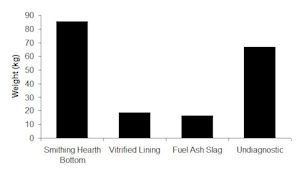
Evidence for smithing was recognised in two main forms; bulk slags and micro slags. Of the bulk slags produced during smithing only the smithing hearth bottoms are unlikely to be confused with the waste products of smelting and are therefore considered to be diagnostic of smithing. These hearth bottoms are recognisable by their characteristic plano-convex form, having a rough convex base and a smoother, vitrified upper surface which is flat, or even slightly hollowed as a result of the downwards pressure of the air blast. Compositionally, smithing hearth bottoms are predominantly fayalitic (iron silicate) and form as a result of high temperature reactions between the iron, iron-scale and silica from either the clay furnace lining or sand used as a flux by the smith.
In addition to bulk slags, iron smithing also produces micro slags of two types. Flake hammerscale consists of fish scale like fragments of the oxide/silicate skin of the iron dislodged during working. Spheroidal hammerscale results from the solidification of small droplets of liquid slag expelled during working, particularly when two components are being fire-welded together or when a slag-rich bloom of iron is first worked into a billet or bar. Hammerscale is considered important in interpreting a site because it is highly diagnostic of smithing. In addition, it often builds up in the immediate vicinity of the smithing hearth and anvil and so may give a more precise location of smithing activity than bulk slags that may be transported elsewhere for disposal (i.e. secondary contexts).
Three categories of slag not considered diagnostic are undiagnostic iron-working slag, vitrified hearth lining and fuel ash slag. The debris classed as undiagnostic iron-working slag is dense (having a composition that is predominantly fayalitic) but the morphology of the slag lumps is irregular and similar materials can be produced by either smelting or smithing operations. Material listed as vitrified hearth/furnace lining can be formed during either iron smelting, iron smithing or non-ferrous metalworking as a result of a high temperature reaction between the clay lining of the hearth/furnace and the alkaline fuel ashes or fayalitic slag. The material consists of fired clay that is vitrified on one side. Occasionally blow holes are preserved in the vitrified linings. The lack of smelting slags from the site indicates that the vitrified linings derive from smithing hearths rather than smelting furnaces. Some of the vitrified hearth lining may derive from non-ferrous metalworking. The occasional slagged stones found may also have formed part of metalworking hearths. Fuel ash slag is a very lightweight, light-coloured (grey-brown), highly porous material which results from the reaction between alkaline fuel ash and silicates from soil, sand or clay at elevated temperatures. The reaction is shared by many pyrotechnological processes and the slag is not diagnostic.
A number of iron objects (identifications assisted by David Starley and Hilary Major) that could be associated with metalworking are also discussed in this report. Stock metal consists of simple bars, usually rectangular in section. Waste consists of either amorphous lumps or, more commonly, small fragments that have been cut from stock metal (cf. Sim 1992). A number of tools were also identified (including punches and chisels), although not all of these are definitely connected to iron smithing.
In total, 140kg of the iron-working slag could be assigned to individual periods (Figure 551); the remainder was unstratified or came from features that could not be assigned to a single period. The total weights of vitrified lining for each period are shown in Figure 552. A single fragment of vitrified lining (20g) came from a feature judged to be of Middle/Late Iron Age transition date. Most of the debris was recovered from Period 2 or 3 contexts (Late Iron Age to Early Roman).
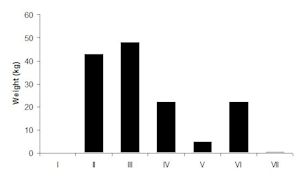
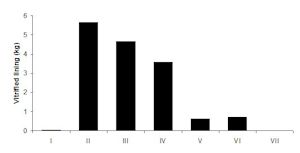
Among the numerous pieces of vitrified lining examined there were seven with blow holes. Three of the blow holes were recovered from Period 2 contexts, two from Period 3, one from Period 6 and one unphased. There are no significant patterns apparent in the chronological distribution of the stock/waste iron fragments.

The spatial distribution of the iron working slags is presented in Figure 553 (expressed as the weight per hectare) and uses the Excavation Area designations (Areas D-R and W). Some of these entities are effectively tangible plots defined by the road and trackway network while others were arbitrary areas of investigation (see Section 2.1). There is a clear concentration of iron smithing debris in Area K. Figure 554 shows the spatial distribution of the vitrified lining. The vitrified lining is concentrated in Areas K and L, and five of the blow holes in the vitrified lining were recovered from Area K. The stock/waste iron tended to be concentrated in the southern part of the site (especially Area H).
Most of the contexts that contain large quantities of iron smithing debris are secondary (pits and ditches). A few structures and features in Areas M and N are tentatively linked to iron smithing. Four small pits in Area M close to Road/Track 4 ([15289], [15306], [15309] and [15385]) were identified as 'industrial pits'. In Area N feature 11477 (interpreted as a hearth or kiln) was constructed in a pit (2m by 2m) with a possible central pedestal. Also in Area N, close to track 3, was a series of pits ([11197], [11228], [11248] and [11050]) which, on parallels with the form and position of the 'industrial pits' in Area M, were linked to possible metalworking. However, these pits produced very small quantities of slag most of which was non-diagnostic, fuel ash slag or vitrified lining. Slag, like domestic refuse, may be incorporated into a wide range of secondary deposits, such as pits and ditches.
During the excavation a large bloom of iron (SF2676; context 11000) was recovered. The bloom is approximately 65mm thick and 210mm in diameter and weighs 12.2kg (giving an approximate density of 5.4gcm-3). Relatively few Roman (or pre- or post-Roman) iron blooms or ingots have been recovered from archaeological contexts in England (Table 113).
The Elms Farm example was recovered while topsoil was removed by machine but the exact find spot within Area M was recorded and it is probable that it derived from pit 15573 or pit 15588 (Periods 2-3).
| Site | Type | Reference | Weight |
|---|---|---|---|
| Forewood, Sussex | Bloom | Smythe 1936-7 | 1.2kg |
| Lower Slaughter, Gloucestershire | Bloom | O'Neil and Brown 1966 | 11kg |
| Cranbrook, Kent | Bloom | Brown 1964 | 0.7kg |
| Corbridge beam | Beam | Bell 1912 | 7.5kg* |
| Catterick beam | Beam | Wright 1972; Starley 1997 | 7.5kg* |
Analysis was undertaken to establish the microstructure and carbon content of the bloom. Macro-examination of a sectional sample showed that the bloom contains high proportions of porosity (24% by volume) and slag (21% by volume), and a density of 5.1gcm-3 calculated - which is in good agreement with the figure estimated above. The microstructure of the bloom is heterogeneous with widely varying amounts of slag, phosphorus and carbon, and is typical of bloomery smelting slags.
This bloom would have been smelted to produce a large spongy mass of solid which would then have been forged to shape. The bloom still contains relatively high proportions of slag and porosity and would have required further forging before it could have been used to manufacture artefacts. However, there is no aspect of the microstructure of the bloom which would allow it to be positively identified as Roman in date, as iron smelting technology changed relatively little between the Iron Age and the later Middle Ages.
The evidence for working non-ferrous alloys (including copper alloys and silver refining) consists of crucibles, moulds, failed castings, metal spillages and litharge. The following account of this assemblage draws on the assessment of the non-ferrous metal working evidence produced by Cath Mortimer (1996).
In total, 273g of crucible fragments (from no more than nine vessels) were recovered and included handmade triangular types (cf. Gussage All Saints, Spratling 1979) and thin-walled wheel-thrown examples (some of which have extra outer layers of clay added to improve strength and thermal insulation). The crucibles were analysed using energy dispersive X-ray fluorescence (EDXRF) to determine which non-ferrous elements (principally copper, zinc, tin and lead) were present (Table 114). Analysis was carried out on metal droplets where they survived on the surface or in cracks. Where no droplets were visible, the most heavily vitrified/coloured region of the crucible was analysed. Such results are more difficult to interpret, however, as zinc and lead levels in a crucible may be much higher than those found in the original metal. For example, EDXRF analysis of a droplet on one crucible indicated a leaded bronze was melted while the analysis of the crucible lip detected only zinc (cf. Dungworth 2000). Nevertheless, EDXRF confirms that most of the crucibles were used for melting copper alloys, and not precious metals.
| Context | Area | Period | Elements detected | Comments | Weight (g) |
|---|---|---|---|---|---|
| 8000 | E | 0 | Cu | 2 | |
| 14573 (Group 8005) | L | 0 | Cu Pb Sn | 12 | |
| 11250 (Group 148) | N | 0 | Cu Zn | 20 | |
| 4433 (Group 62) | K | 2 | Cu Zn | 71 | |
| 11156 (Group 207) | N | 2 | Cu Pb Sn Zn | 2 fragments, handmade | 119 |
| 11156 (Group 207) | N | 2 | Zn | Extra outer layer | 11 |
| 11343 (Group 59) | N | ? | Cu Pb Zn | 8 | |
| 11343 (Group 59) | N | ? | Au Cu | 8 | |
| 21809 (Group 6003) | J | ? | Ag Cu Pb Zn | Pedestal base and wall sherd | 22 |
Approximately 2kg of ceramic mould material provides evidence for casting in both piece moulds and lost wax moulds (see below). Ceramic moulds are not usually fired to a high temperature, are friable and so rarely survive archaeologically in large quantities. The fairly modest quantities of ceramic mould from Elms Farm that have been recovered may be a small proportion of the moulds originally used. The piece moulds were used for casting rings or flat plates while the lost wax mould fragments indicate the casting of statuary.
The EDXRF analysis of a selection of metal spillages (Mortimer 1996) indicated that leaded bronze was commonly used to produce castings.
Silver was detected in two crucibles and gold in a single crucible. The refining of silver is indicated by three fragments from litharge cakes (two unstratified and one from a Roman context).
Cite this as: Major, H. 2015, Ceramic crucibles and moulds, in M. Atkinson and S.J. Preston Heybridge: A Late Iron Age and Roman Settlement, Excavations at Elms Farm 1993-5, Internet Archaeology 40. http://dx.doi.org/10.11141/ia.40.1.major1
The metallurgical aspects of the crucibles are discussed above. Thirty-seven fragments of crucible were recovered, weighing 441g. There were no contexts with both crucible and mould fragments. Seven contexts contained crucibles, two of which were undated, four were Period 2, and one was Period 6 (21809; Figure 555. no. 4). As noted above, the crucible from the latter context was of a type common in the late 1st and 2nd centuries AD, and therefore likely to be residual.
1. Pedestal base in a rather friable fabric, fired to a pinkish tinge. Seven other fragments of body and base may be part of the same vessel, though none joins to the base. If these are parts of the crucible, then the complete object would have been at least 70mm tall, with a bowl-shaped upper part with an external diameter of c. 80mm. Fill 11156, Pit 11197, Group 207, Area N, Period 2
2. Rim and a body sherd (not illustrated), probably both the same crucible, but non-joining. A straight-sided vessel with the base missing. Ht >33mm. Fill 11250, Ditch 11259, Group 148, Area N, Period 2
3. Rim from a shallow bowl crucible. Fill 11343, Pit 11344, Area N, Period 2
4. Base and joining bodysherd from a crucible with a slight pedestal foot. Build-up layer 21809, Group 6003, Area J, Period 6
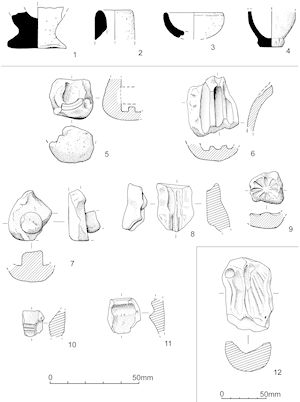
5. Side from a mould for at least two rings with circumferential grooves round the outer edges. The core has broken off. External diam. of rings 37mm, internal diam. 20mm, Th. c. 4mm. Wt 56g. Fill 13446, Slot 13447, Group 172, Area J, Period 2B-3
6. Three curved grooves on the interior, with an almost semi-circular section. There is a trace of the pouring channel at the top of the middle groove. The rings would have had an external diameter of c. 60mm, and would have been about 9mm thick. Wt 54g. Fill 14572, Pit 14382, Group 260, Area L, Period 2B
7. Side from a mould with part of the pouring hole and a broken central, cylindrical core. The object would have been annular, possibly a cylinder rather than a ring. Object external diameter c. 40mm, internal diam. 26mm, surviving core Ht 11mm. Wt 54g. Fill 15418, Pit 15417, Group 33, Area M, Period 2
8. Four pieces with two pouring holes, each leading to one ring; one piece is illustrated. There were possibly only two rings per mould in this group. The tops are slightly cupped. L. of pouring hole c. 28-30mm. Wt 140g. Fill 15418, Pit 15417, Group 33, Area M, Period 2
9. Ten-petalled boss or stud head with a concave centre. The petals are of uneven widths. Diam. 30mm. Wt 21g. SF7408, Fill 15745, Pit 15744, Group 691, Area M, Period 3
10. Mould for an unidentified object with one flat face at least 17mm long and 15mm wide, at an angle of c. 135° to a face with three narrow transverse grooves, at least 15mm long. Wt 12g. Machining layer 4002, Area A
11. Two pieces, possibly from the same mould; one piece only is illustrated. The mould is for an unidentified object, possibly a knob or terminal. It appears to have two sub-spherical units on top of an angled base. Surviving L. of object c. 40mm. Wt 22g. Fill 4840, Pit 4786, Group 276, Area K, Period 2-3
12. Mould fragment. This appears to be a mould for drapery, so is probably for a statuette. It is a much larger fragment than the other moulds from the site, and is in a different fabric. The fabric is more similar to a tile fabric than the other moulds. The inner surface is not reduced, so it is apparently unused. L. 84mm, W. 55mm. Wt 114g. Cleaning layer 23002, Area N, not dated
Cite this as: Major, H. 2015, Mis-cast and unfinished copper-alloy objects, in M. Atkinson and S.J. Preston Heybridge: A Late Iron Age and Roman Settlement, Excavations at Elms Farm 1993-5, Internet Archaeology 40. http://dx.doi.org/10.11141/ia.40.1.major5
A number of objects were discarded mis-castings. The identifiable pieces included a knobbed bar terminal (SF821), and two bell-shaped studs. Other pieces are possible mis-castings. The ring and stud (SF2496 and SF2275) may simply be poorly finished and the knob (SF6799) may be distorted due to burning. SF821 (no. 18) could be post-Roman. Only two of the objects in this category are from stratified contexts. There is a possible unfinished stud from a transitional context in Area L (no. 22), and a second stud from a 3rd to 4th-century context. No object is necessarily related to the mould evidence, which is all Early Roman.
Evidence for local production of brooches is considered in the brooch report.
13. Not illustrated. Badly mis-cast bell-shaped stud. It has an incomplete solid cylindrical base. The entire rim of the bell is missing. Intended diam. c. 30mm. SF2489, Machining layer 4000, Area A, unstratified
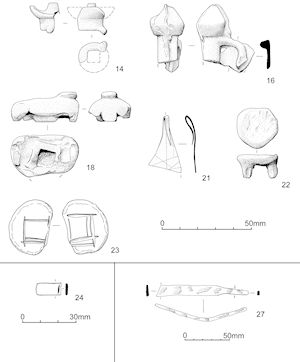
14. Broken mis-casting of a bell-shaped stud. One side is missing, and the stub of the sprue is present on the side of the base. The base was hollow. Diam. 26mm, surviving Ht 16mm. SF2490, Machining layer 4000, Area A, unstratified
15. Not illustrated. Curved rod fragment, possibly part of a ring, with an irregular projection on the edge. The surface is poorly finished, with a crude groove round each side. Possibly a mis-cast ring. L. 37mm, Diam. 8mm. SF2496, Machining layer 4000, Area A, unstratified
16. Incomplete mis-cast object. It comprises a rod with a biconical terminal. There is a curved projecting rod just below the terminal, but it is unclear whether this is an intrinsic part of the object. It appears that one half of the two-part mould was not properly aligned, as metal penetrated the join, and one side of the object has not come out properly. L. 37mm, W. 29mm, rod diam. 10mm. SF821, Machining layer 4000, Area A, unstratified
17. Not illustrated. Stud fragment, complete as buried. The shank is incomplete. The flat top was probably circular, and is poorly finished. Possibly a mis-casting, or an unfinished object. Surviving diam. 20mm, Ht 8mm. SF2275, Cleaning layer 5543, Area J, Period 5-6
18. Mis-cast object or casting waste. An oval object with one convex surface. There is a small round button at one end on this surface. The other face has a complex shape, with a rectangular ?socket in the middle, with a hollow either side. 38x23x17mm. SF5423, Machining layer 11000, Area A, unstratified
19. Not illustrated. Knob fragment, similar to SF1281 (function category 4, no. 122), though slightly smaller. It is either a mis-casting, or burnt. The upper collar is twisted, and probably has a separate blob of copper alloy attached. The details are difficult to see, as the object is partly covered in earth. SF1281 is possibly an element from a piece of furniture, so if SF6799 is a mis-casting, it suggests the manufacture of furniture at Elms Farm. Original height c. 35mm, Diam. not measurable. SF6799, Machining layer 11000, Area A, unstratified
20. Not illustrated. Unfinished stud? In poor condition. Incomplete shaft, surface flaked, section indeterminate, with an applied square-sectioned collar at one end. L. 16mm, head W. 6mm. SF7356, Fill 20031, Pit 20030, Group 248, Area L, Period 2B
The other waste material from the manufacture of copper-alloy objects has been broadly divided into three categories: offcuts, waste and scrap, and globules etc.
Offcuts comprise sheet and strip fragments with cut edges that were deemed to be waste fragments produced during the manufacture of another object. They are typically irregular in shape. One piece (no. 23) has faint scribed lines.
Waste and scrap includes metal that has been deliberately broken or cut up for recycling (scrap), and fragments with a fairly regular shape such as cut bars. It is difficult distinguishing between scrap and waste. Some recognisable objects, most of which have been included in other categories, were probably scrap metal. In particular, two Late Roman military belt fittings (SF7197 and SF5710, both unstratified; FF13, nos 41 and 42) and an unstratified skillet handle appear to have been cut up in antiquity, presumably as a preliminary to being melted down. The Early Roman coin (no.23) may have been in the process of being cut up for reuse (Figure 556).
'Globules' include small amorphous lumps, probably dribbles from casting, and irregular fragments that appear complete as buried, and which give no indication of being part of an actually object.
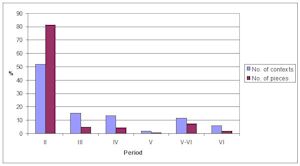
The fragments themselves are generally uninformative, but the chronological distribution is of some interest. Out of the fifty-two closely phased contexts that contain copper-alloy working waste, 52% are Period 2, and these contexts contain 81% of the 165 pieces from closely phased contexts (Figure 557). There is therefore a clear concentration of working waste in the Late Iron Age/Transitional Period, which fits in with the evidence of the crucibles and moulds. Copper-alloy working does not cease after this period, as the evidence of the Late Roman scrap metal shows, but it seems to have been of more importance to the economy of the site early in its life.
21. Offcut. Elongated triangle with the apex turned over. One face has several faint scribed lines. In good condition. W. 19mm, L. (straight) 46mm. SF667, Machining layer 4000, Area A, unstratified
22. Crudely formed plano-convex disc, with two stubby projections on the convex face. Casting waste. Diam. 23mm. SF673, Machining layer 4000, Area A, unstratified
23. Part of an Early Roman coin, with very little detail surviving. It appears to be in the process of being cut into a rectangle; one edge has been completely cut through, and both faces have deep chisel marks, forming a rough rectangle. Presumably the coin was being used as scrap metal. Diam. 31mm. SF6375, Machining layer 12000, Area R
24. Small rectangular offcut with cut marks at one end. 14x6x1mm SF6565, Machining layer 17000, Area Q (Figure 556)
About 150 pieces of iron were classified as definite or probably iron-working waste, some of which were identified by David Dungworth during examination of the ferrous slag. They included stock and offcuts, and a few possible unfinished objects, including knives (one is illustrated here, another is no. 19). It has been noted elsewhere that folding knives may have been made at the site, one possibly unfinished (nos 34-37).
25. Not illustrated. Tanged strip, both ends missing. The tang is bent at c. 90°, and the tip at c. 45°. While superficially resembling a narrow-bladed trowel, it seems more likely that this is a knife, discarded during manufacture. The tang appears to be set off-centre, though not in line with the back (the X-ray is unclear), and the blade is thick, with no sharpened edge. The edge that would have been the back is slightly angled towards the tip, as, for example, Manning Type 17. L. (flat) 169mm, W. of blade 25mm. SF2236, Tile spread 10259, Group 818, Road 1, Period 4
26. Not illustrated. Curved bar fragment with a tapering square section. The wider end is roughly diamond-shaped in plan; it is unclear whether it is complete. This may be an unfinished object, perhaps a blank for a large triangular-headed nail, or even a bucket handle. L. 180mm, max. section 12x12mm, terminal W. 20mm. SF7184, Fill 16230, Ditch 16231, Group 584, Period 6
27. Tapering strip fragment, slightly curved lengthwise, with a 'tang' at one end (Figure 556). It is possibly an unfinished knife blade. The section is rectangular, with no edge. L. 102mm, W. 14mm, tang 24x6x3mm. SF7798, Fill 24003, Pit 24004, Group 712, Period 6
Cite this as: Tyrrell, R. 2015, Lead casting and working waste, in M. Atkinson and S.J. Preston Heybridge: A Late Iron Age and Roman Settlement, Excavations at Elms Farm 1993-5, Internet Archaeology 40. http://dx.doi.org/10.11141/ia.40.1.tyrrell7
The site produced 2550 fragments of possible lead casting waste and related material, weighing 43.828kg. In addition there were 1092 pieces of scrap weighing 17.764kg, bringing the total to 61.592kg. Material from machine stripping (11000) forms 88% of this total, collected by 10m square with the intention of plotting its distribution across the site, providing a useful pointer to possible lead-working areas. Unfortunately, due to a misunderstanding, the material was bulked prior to recording, and it was not possible to plot its distribution. This still leaves a fairly substantial assemblage for consideration, and the quantity alone is remarkable.
A cautionary note should be added here that not all the melted lead is necessarily working waste, because it melts at a relatively low temperature. It can be melted accidentally in a simple domestic hearth or a house fire. However, it is very difficult distinguishing accidentally melted lead from casting waste, and all has been included in this category, whatever its source.
The lead waste has been divided into material that may relate to working the metal, and otherwise unidentifiable pieces of lead that may have been collected for recycling. Some of the identified objects may also be 'scrap', but it is difficult to assess the quantities involved. The waste has been classified in the following way.
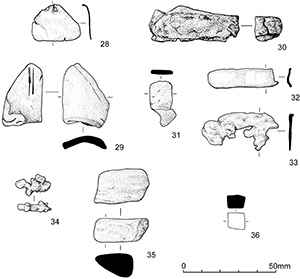
Sheet (Figure 558, no. 28)
Both surfaces are smooth, or nearly so, with fairly constant thickness, usually very thin but crumpled. There were 38 pieces of thick sheet, total weight 935g and 244 pieces of thin (less than 2mm thick) sheet, total weight 2.393kg.
Offcut (Figure 558, no. 29)
Clear signs of cutting, usually but not always sheet. There were 273 offcuts, total weight 6.797kg.
Scrap (Figure 558, no. 30)
Irregular three-dimensional forms, though not as irregular as dribbles, and without the melted appearance. There were 478 scraps, total weight 6.544kg.
Flat scrap (Figure 558, no. 31)
This is similar to the scrap, but roughly flat and without the cut edges of the offcuts. There were fifty-four flat scraps, total weight 0.892kg.
Strips (Figure 558, no. 32)
Sheet fragments, relatively narrow for their length. Some may be sections of thick sheet that happen to have roughly symmetrical shapes. There were five strips weighing 203g.
Puddles (Figure 558, no. 33)
Asymmetrical in form, and with one roughly flat side. These formations are the result of molten lead falling on an uneven surface. There were 1736 puddles, total weight 28.633kg.
Dribbles (Figure 558, no. 34)
Very irregular in form, often with little knobbly tentacles and a very lumpy surface. Presumably, these are splashes of molten metal, which cooled quickly, perhaps in water. There were 775 dribbles, total weight 9.226kg.
Blocks (Figure 558, no. 35)
Heavy, angular and irregular lumps of solid metal. These could be the result of the melting down of second-hand objects, or metal arriving on site to be worked, or items to be traded on from Heybridge. When broken, some of the blocks appeared to be mineralised. (No metallurgical tests were carried out on this material.) There were thirty-eight blocks, total weight 5.949kg.
There were examples of most of the types of waste from dated contexts. Details of the distribution by area, period, and type of waste can be found in the archive; overall quantities by period are given in Table 115. The dated material represents less than 8% of the total lead waste from the site, and none of the contexts contained significant amounts of waste. Some of the large quantity of lead found during the stripping of the topsoil may result from post-medieval activity. There were intrinsically datable post-Roman finds in other metals present in the topsoil; for example, 11% of the copper-alloy objects recovered during machining were medieval or later.
| Period | 2 | 2-3 | 3 | 4 | 4-5 | 5 | 5-6 | 6 |
|---|---|---|---|---|---|---|---|---|
| Weight (g) | 374 | 6 | 322 | 193 | 1 | 361 | 482 | 2848 |
| % | 8.2 | 0.1 | 7.0 | 4.2 | 0.0 | 7.9 | 10.5 | 62.1 |
It has proved difficult to pin down the location of any specific lead working areas on the site. The relatively low melting point of this metal means that lead working does not require specialist ovens or kilns. A domestic type of hearth is sufficient. A number of crucibles and moulds were found during the excavations, but none of those tested had traces of lead. The large quantities of puddles and dribbles of molten metal suggest that they were very careless about the wasted metal. A more precious metal would have been collected for reuse. Much of the cast waste evidence cannot be used to highlight densities of deposition because of the vagueness of many of the provenances. However, if these are removed from the equation, some suggestions may be made.
By weight, 54% of the stratified material was found in Area J, but it must be remembered that this was the most intensively excavated area of the site. Despite this, the quantities present suggest that the focus of activity in Area J was around the mid- to Late Roman period. In particular a pit, 5450, and a robber trench, 5400, both in Building 63, contained 742g and 780g respectively of lead waste, although the presence of burnt copper-alloy objects and burnt pottery may mean that the lead from this building was accidentally melted rather than the result of casting.
The chronological pattern of deposition for the site as a whole is similar to Area J, in that while a limited amount of activity was going on in Period 2, 85% of the dated possible lead casting waste was found in mid- to latest Roman contexts. What was being cast remains debatable but the large quantities of weights found on the site must be the likeliest candidate.
A strip of opaque red glass (SF173) was found in pit 3580 (Area W) dated to the mid- to late 1st century AD (Period 3). The strip was 21mm long and had a rectangular cross-section 12x3mmm; it had been cut or broken at both ends from a longer piece of glass. The surface had slight striations along its length, suggesting it had been drawn down from a larger-sectioned block of molten glass (see Figure 716). Analysis showed it had a composition typical of bright 'sealing-wax' red Roman enamels.
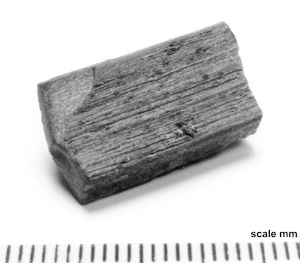
The presence of this glass strip is evidence that enamelling was probably practised at the settlement in the 1st century. The types of objects being decorated in this way at Heybridge are not known. Four hairpins with inlaid heads (Cool type 21) from the site, one of which still contained its glass inlay, have been conjectured to be made here, though this cannot be substantiated by this evidence.
Cubes and chips of opaque blue glass, occasionally opaque green, are found on many sites and it is customary to call them tesserae. Blue glass tesserae are sometimes found in mosaics in order to pick out detail, for instance, the eyes in human figures. However, the use of glass tesserae in Romano-British mosaics is very rare (Neal 1981, 20) and blue cubes have been found on sites where there are no mosaic pavements, including Elms Farm. Use in the manufacture of beads has been proposed (Guido 1978, 37), and, if not for beads, then it is likely that these cubes were used in another industrial process, perhaps for enamelling. Fifty of these tesserae were found at Castleford, many of them heat-distorted (Cool and Price 1998, 193), although their location gave no clue as to precisely which industrial activity was taking place. Both bead-making and enamelling are likely candidates. Manufacturing activity of various types took place at Elms Farm, but the tesserae recovered provide little information; the cubic tessera was found in a Late Roman post-hole, the other was unstratified.
36. Tessera, regular rectangular shape. Opaque blue. Dimensions 9x8.5x6.5mm. SF7526, Fill 20556, Post-hole 20555, Group 5014, Area L, Period 5-6. (Figure 558)
37. Not illustrated. Triangular chip, ?tessera. Opaque blue. Dimensions 9x6.2x4mm. 12000, Area R, unstratified
Few distinctive objects or waste pieces have been recognised that are associated with the working of antler, horn, bone or teeth. Two unidentified, possibly unfinished, worked bone items are included in function category 20 (see FF20, nos 151-2) that likely derive from manufacture at Heybridge.
While there is no such evidence for the use of horn and tooth as a manufacturing material, sawn bone, particularly antler, is present among the wider faunal assemblage retrieved from settlement deposits. Indeed, analysis of the animal bone has identified two metapodials that had been sawn horizontally through the shaft (see Animal bone report) and that are tentatively regarded as the waste products of bone working. Of particular note is the group of antler fragments retrieved from Early Saxon pit 14529 (Area K) that comprises sawn-off burrs, junctions and tine tips.
No objects and waste associated with either pottery vessel or pipeclay object manufacture have been identified other than the products themselves, which are reported upon elsewhere. Pottery vessel wasters are considered as an aspect of the Late Iron Age and Roman pottery assemblage and pipeclay figurines (not manufactured at Heybridge) as components of FF 14 (Religious and ritual activity).
In the absence of diagnostic tools, the clay-built structures of the kilns themselves are the principal vestiges of manufacture at Heybridge. Samples of this material were collected and are described below. The incidence of kiln furniture is low and restricted only to a number of firebar fragments among the debris associated with the structures in Area W.
Cite this as: Tyrrell, R. 2015, Kiln fabric and furniture, in M. Atkinson and S.J. Preston Heybridge: A Late Iron Age and Roman Settlement, Excavations at Elms Farm 1993-5, Internet Archaeology 40. http://dx.doi.org/10.11141/ia.40.1.tyrrell6
Kiln fabric is here considered to be burnt clay deriving from the structure of a kiln, and fragments from other contexts that are visibly similar. In total, 6766 fragments of this material, weighing 272.234kg, were recovered from the various kilns and other related features excavated on the site for the purposes of fabric and functional analysis. The quantities of material recovered from each kiln are presented in Table. 116. In addition, seven possible firebar fragments were collected. These are described alongside the structural fabric where they occur in kiln-related deposits.
| Feature | Site area | Weight (kg) | Count |
|---|---|---|---|
| Kiln 1618, Group 906 | W | 42.967 | 1009 |
| Kiln 1223, Group 908 | W | 133.496 | 2498 |
| Stoke pit 1589, Group 910 | W | 13.609 | 404 |
| Debris over 1618 & 1223, Group 909 | W | 0.476 | 20 |
| Kiln 11423, Group 693 | N | 27.338 | 1516 |
| Kiln 14858, Group 714 | L | 25.246 | 516 |
| Kiln 10906, Group 672 | N | 10.038 | 275 |
| Kiln/hearth 11477, Group 55 | N | 6.900 | 138 |
| 11477 related material, Group 55 | N | 12.164 | 300 |
On examination, six fabrics were found to be present (Figure 559). These were identified macroscopically as follows.
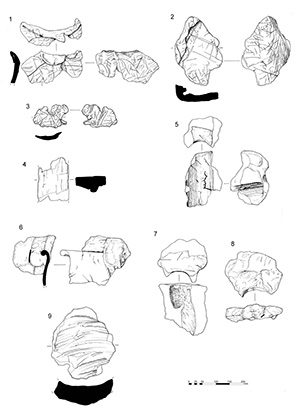
Fabric A: A low fired, evenly mixed fabric, with very little vegetable tempering and sparse sand. The fabric is light in weight and typically creamy orange to red in colour, with both surfaces covered with impressions of what looks like long, fine grass. These fragments varied between 11 and 27mm thick and were generally fairly flat, but sometimes curved up almost into rim like shapes (Figure 559, 1). There were 541 pieces, weighing 37.680kg, mostly from the stoke pit of Kilns 1618 and 1223.
Fabric B: A highly fired fabric with moderate sand, sparse vegetable tempering and inclusions of some fairly large sherds of pottery (Figure 559, 4). The colour range is grey to red. This fabric occurs as irregular chunks and it is therefore difficult give any meaningful measurements. The possible ?vent holes (Figure 559, 6 and 7) in this fabric are vitrified, in some cases to an almost green glaze-like state. There were 404 pieces, weighing 26.774 kg. 82% of Fabric B was found in Kiln 1223.
Fabric C: Similar to Fabric B but with a less highly fired appearance. There is slightly more sand, some small fragments of flint, and sparse vegetable temper. The colour ranges from buff to pale orange. These may be the outer layers of the kilns, which would have been less heavily fired. This was the commonest of the fabrics, with 4890 pieces, weighing 149.147kg.
Fabric D: A very low fired clay with almost no visible tempering. The fragments are an even dark orange in colour and fragmented to small crumbs (3-4mm). There were 138 pieces, weighing 6.900kg. This material only came from the possible kiln 11477 and was thought by the excavator to be the heat-damaged tile lining of the feature, but it is more likely to be a thin, flat layer of hard-baked clay kiln base. Two fragments of straight-sided slabs, 35mm thick, possible kiln furniture, were also made in this fabric.
Fabric E: An even lower fired clay with almost no visible tempering. It was found only in Kiln 11423, where it lined the chamber and the flue. There were 609 pieces, weighing 22.473kg.
Fabric F: This material is similar in make-up to Fabric B but less highly fired and with no original surface surviving. There were 135 pieces, weighing 26.892kg, from Kilns 14858 and 10906.
Tile fragments and pieces of septaria were also present in the assemblage from kiln constructions, but are not discussed here.
The ditches in Area W that produced fragments of Fabrics A and B are not far from Kilns 1618 and 1223, and clearly derive from them. The similar pieces of Fabric A from post-hole 11322, many metres away are more difficult to explain. It must be assumed that they were incidentally deposited. Fabric A or B did not occur in Kilns 11423, 14858 and 10906. Fabrics C and F occur in the latter three kilns but C and E only in Kiln 11423.
All the Elms Farm kilns are of the single chamber, single-flued variety, with a central circular pedestal. The kilns had been cleared of their final firing; there were, however, fragments of kiln fabric found in and around their structural remains. The majority of material (see Table 116) comes from Kilns 1618 and 1223, which were better preserved than the remainder. These two kilns were positioned side by side with their flues pointing NE and NNE to a shared shallow stoke-pit, from which much of the structural debris was recovered. Kiln 1223 had been badly damaged by the cutting of a later ditch. What remains of it suggests that it was similar to 1618 in shape and construction, although damage to the pedestal means that its shape is less well defined. Kiln/hearth 11477 has been included because of the kiln-like shape of the feature.
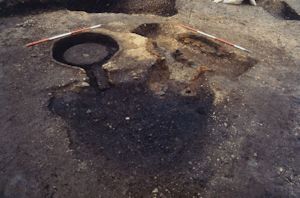
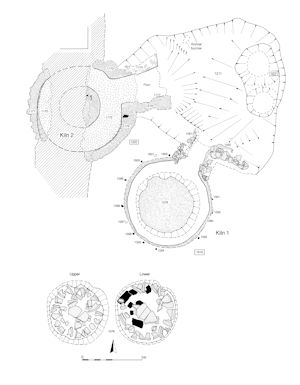
This kiln was built in a circular clay-lined cut 1.70m in diameter and 0.32m deep, and is of the standard, East Anglian style, Wattisfield type (Swan 1984, 115-16). Between the construction cut of the kiln and the lining were twelve stake-holes ranging from 0.32m to 0.25m deep and from 0.09m to 0.05m in width. These were evenly spaced around the circumference of the kiln and perhaps are evidence for the construction of the dome. The early 4th-century kiln excavated at Ivy Chimneys, Witham (Turner 1999, 47-50) had a similar arrangement of stake-holes. Wattle-like impressions were recorded in some of the kiln material, measuring 17, 45, 48 and 63mm in diameter. Presumably these came from the superstructure of the kiln.
The upper surface of the pedestal and the structure of the flue were reinforced with two layers of pottery sherds, mostly mortaria, but with some amphora and greyware. The Ivy Chimneys kiln (Turner 1999, 50) had pieces of tile set in the pedestal. It is difficult to be certain whether this was the original method of construction or a repair. A number of the mortaria sherds were stamped and have been dated to AD 160-190, and there is an archaeomagnetic date of AD 140-170 for the last firing of this kiln. However, the pottery dating suggests that Kiln 1618 was constructed in the late 2nd or early 3rd century AD and abandoned during the early 3rd century AD. The pottery dating implies that this kiln may have been taken out of production before the adjacent one and perhaps this is the reason why there was less structural debris surviving. The fragments of fabrics A, B and C present have impressions and vitrification as discussed below.
A later ditch 25106 (seg. 447) was cut across Kiln 1223, removing much of its pedestal (Figure 144 and Figure 173). Nevertheless a number of interesting features were preserved. This kiln is similar in size to Kiln 1618, being built in a circular clay-lined cut 1.65m in diameter and 0.20m deep. The more substantial thickness of its walls is noteworthy, as is the greater amount of heat damage in the form of cracking, discolouring and vitrification, which suggests either a longer life or more intense heat and/or perhaps a subtly differing function.
There is an archaeomagnetic date of AD 90-210 for the last firing of the kiln. A number of sherds of greyware dating to the 3rd century AD were found embedded in the surviving wall of the firing chamber (Figure 559, no. 5). There is perhaps more fabric relating to this kiln than to the adjacent one for the reason already suggested. Fabrics A, B and C are represented in the assemblage.
The shared stoke-pit of kilns 1618 and 1223 contained, in addition to charcoal, a large quantity of featureless fragments of kiln structure that presumably were parts of both kilns. Some of the larger chunks of the highly fired material had been perforated by holes with a diameter of 40-50mm (Figure 559, nos 4, 6, 7 and 9). While the rough inner surfaces of these tubes are vitrified and cracked, the surface at right-angles to one of them is wiped smooth and has no vitrification. Various suggestions have been made as to the function of these holes in the kiln. The author's first assumption was that they were the slots that held the firebars, as at Spong Hill, Norfolk (Swan 1984, pl. 16). This is not likely for Kiln 1618, as the wall survives above the level of the pedestal and such holes would have survived in situ if they ever existed, which was not the case. In addition if they were firebar slots they would not have been subjected to such a great amount of heat on the inner surfaces as they show. It is possible that they could have been vents in the dome or, as R. Darrah (pers. comm.) has suggested, associated with tuyères, which would explain the vitrification. Indeed the degree of heat damage suggests that they must have been internally placed whatever their function. Alternatively these fragments with holes could be from kiln furniture, in the form of perforated plates as seen in Lower Nene Valley kilns (Swan 1984, fig. VIII), or a perforated lintel plate as at Biddlesden, Bucks (Woods et al. 1981), or part of a perforated firing floor. The latter interpretation seems unlikely for Kiln 1618, as it survives above the level at which such a floor would have been, and there would have been traces of where it was luted to the kiln wall. Since Kiln 1223 has been damaged it is not certain how the firing floor was built.
The second class of fragments present in the stoke pit consists of grass-impressed flattish masses of baked clay (Fig.559, nos 1-3). The function of these remains uncertain, but since they are not highly fired it is possible that they were part of the outer dome, as patches to counteract heat loss (Tim Robey, pers. comm.). Alternatively, R. Darrah (pers. comm.) has suggested that they may be from a clay settling pit, which used layers of grass or hay as a filter, or that grass was used as a bed to dry the clay slurry. How the material became baked is more difficult to explain.
Four of the seven possible firebar fragments (Figure 559, no. 8) come from the stoke-pit, and appear to be of the untapered clay bar type which is commonest in the area of the Thames Estuary (Swan 1984, 64). It is difficult to be sure of the dimensions of these objects because of their fragmentary nature. The rest were in Kiln 1223, so it is tempting to suggest this was the source of the firebars from the stoke-pit. One of the bar fragments retained the impression of a stick at its core, similar to an example from Wood Burcote, Northants (Swan 1984).
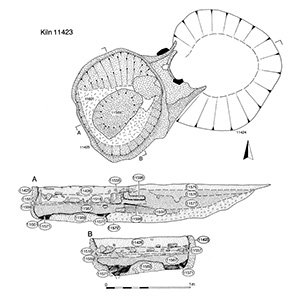 - Kiln 11423 (Group 693)
- Kiln 11423 (Group 693) This kiln was built in a slightly oval clay-lined cut 1.3m to 1.5m in diameter and 0.50m deep. Although the clay lining of the kiln survived well above the level of the top of the pedestal, there were no signs of a ledge or slots for firebars. The south-facing flue had been repaired or reinforced with fragments of tile, and it is possible that the fragments of tile in stoke-pit 1589 had also been used in this way. The fragments of Fabrics C and E from this kiln were not fired to the same degree as those from the Area W kilns, and have no diagnostic features preserved on or in them. An archaeomagnetic date of AD 225-250 has been given for the last firing of this kiln. The pottery dates the abandonment to around the mid-3rd century AD having been in use, in parallel with Kiln 10906, since the second half of the 2nd century AD. The structural material of both kilns is similar.
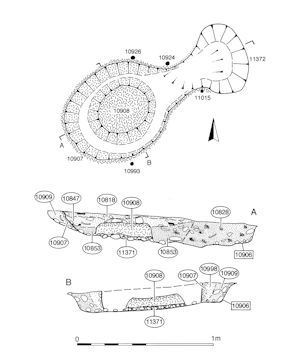
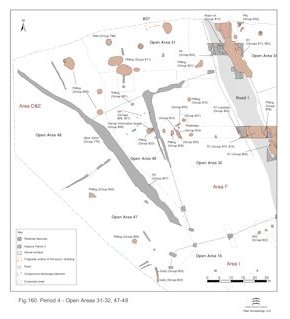
This kiln was also built in a circular clay-lined cut, 1.3m in diameter and 0.40m deep. The flue faced east but the kiln was otherwise very similar to Kiln 11423. The baked clay kiln material was made from Fabrics C and F, with no distinguishing marks. A number of small fragments of tegulae and septaria had been used in construction or repair. An archaeomagnetic date of AD 150-210 or 270-400 has been given for the last firing of this kiln. The pottery dates suggest that the kiln stopped production before the mid-4th century AD.
This kiln is similar in shape to the other kilns, but it is only 1.2m in diameter and 0.40m deep (Figure 159). The lining material, formed of clay Fabric F, does not exhibit much evidence of great heat. The fabrics present are similar to Kiln 14858. The pottery found in the kiln, which is not thought to have been that produced in it, dates the abandonment to the first half of the 3rd century AD.
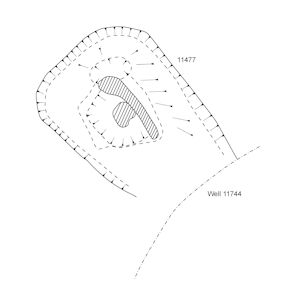
This possible kiln seems to have been inserted into the slumped area of an earlier pit and has been included here because of the kiln-like shape and the traces of a pedestal which were present. The crucible fragments and copper-alloy casting waste from its upper fills may indicate that it was used for metallurgy rather than pottery production. The retrieved structural material is of Fabric D. The nearly 7kg of material from the feature includes two heat-damaged fragments of straight-edged slabs 35mm thick. The pieces are 102x92mm and 117x94mm, but could be from much larger objects, possibly firebars or kiln floor. The pottery from this feature suggests that it dates from the late 1st century BC to early 1st century AD (Period 2A), rather early for a kiln of this form.
See Figure 559
1. Fragment of vegetable-impressed baked clay curved up to form the edges of holes. Fabric A. Context 1180, Kiln 1223.
2. Fragment of vegetable-impressed baked clay with the deeper mark of a plant root in the surface. Fabric A. Context 1180, Kiln 1223.
3. Fragment of vegetable-impressed baked clay curved up to form the edges of holes. Fabric A. Context 1180, Kiln 1223.
4. Surface fragment with part of a 'vent' hole at right angles to it and with a possible textile impression preserved in it. Fabric B. Context 1174, Kiln 1223.
5. Lump of kiln structure with a rim sherd of pottery pressed into it. Fabric C. Context 1098, Kiln 1223.
6. Fragment of kiln material with a vitrified 'vent' hole at right-angles to an unevenly finished surface, possibly an outer one. Fabric B. Context 1092, Kiln 1223.8
7. Kiln material fragment with a partially vitrified 'vent' hole at right-angles to a surface with a wiped finish. There is also the impression of a pot rim on the reverse (not shown). Fabric B. Context 1174, Kiln 1223.
8. Part of a possible parallel-sided firebar. Fabric C. Context 1045, Kiln 1223.
9. A curved vitrified kiln material fragment with a wiped finish, possibly the inner surface of a domed superstructure. Fabric C. Context 1508, Kiln 1618.
Internet Archaeology is an open access journal based in the Department of Archaeology, University of York. Except where otherwise noted, content from this work may be used under the terms of the Creative Commons Attribution 3.0 (CC BY) Unported licence, which permits unrestricted use, distribution, and reproduction in any medium, provided that attribution to the author(s), the title of the work, the Internet Archaeology journal and the relevant URL/DOI are given.
Terms and Conditions | Legal Statements | Privacy Policy | Cookies Policy | Citing Internet Archaeology
Internet Archaeology content is preserved for the long term with the Archaeology Data Service. Help sustain and support open access publication by donating to our Open Access Archaeology Fund.